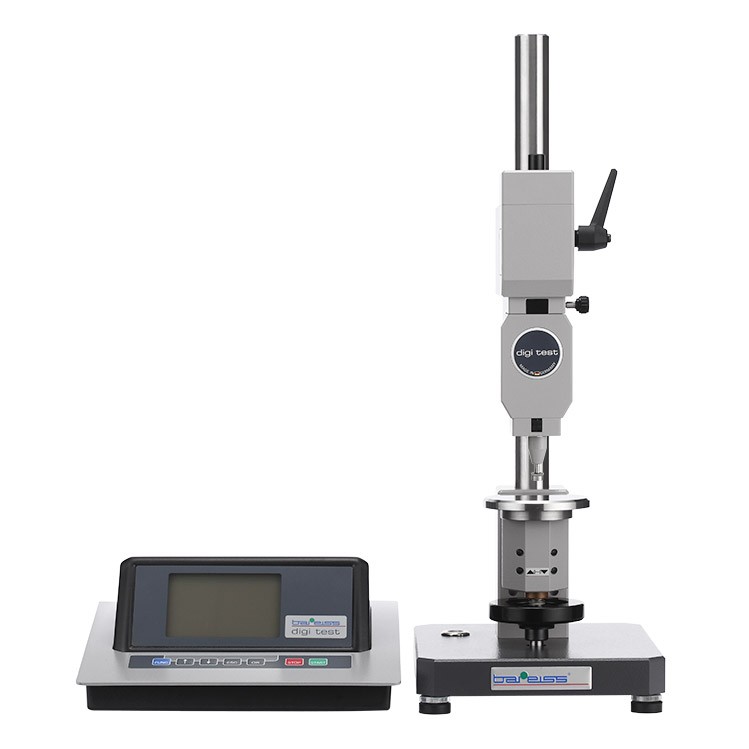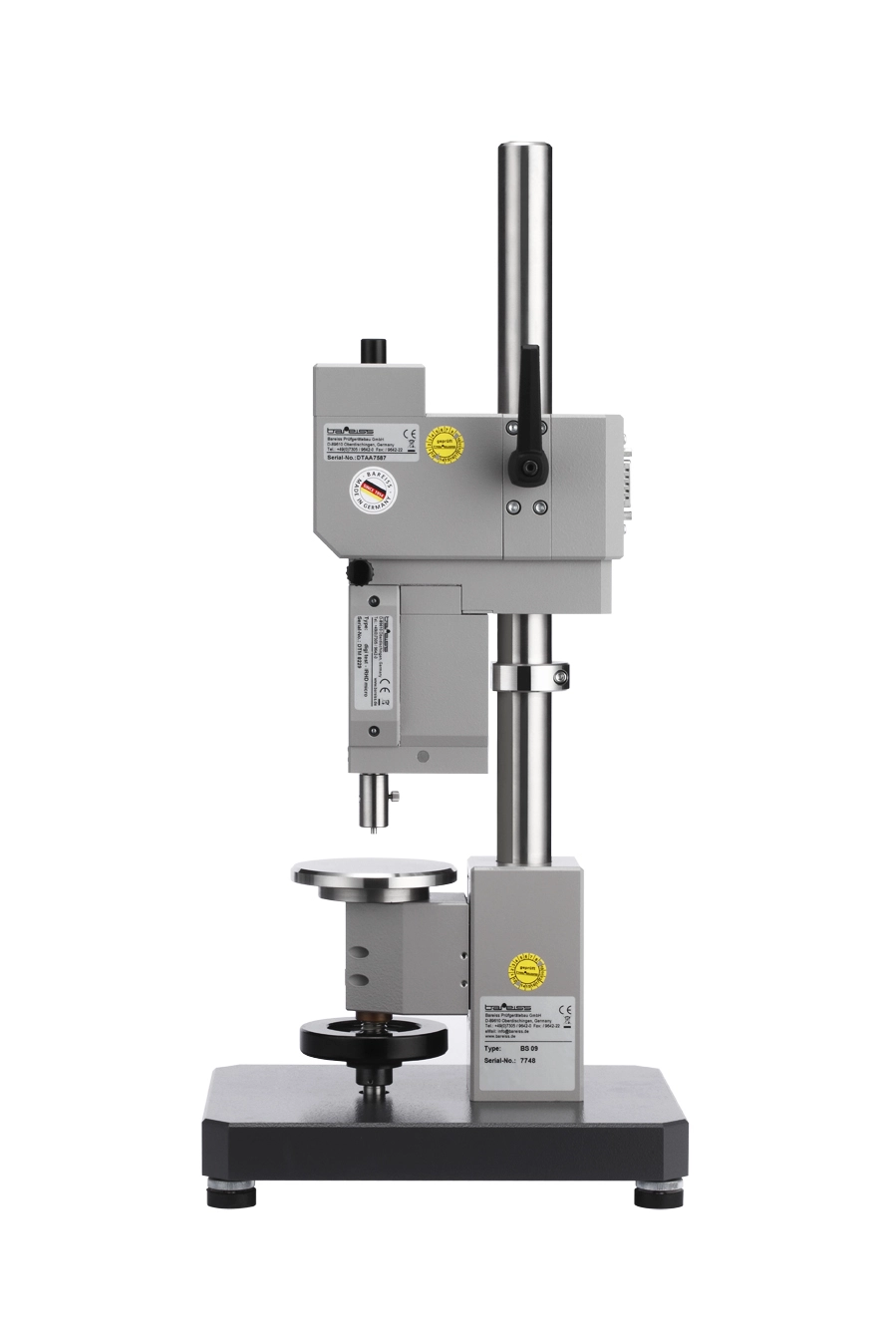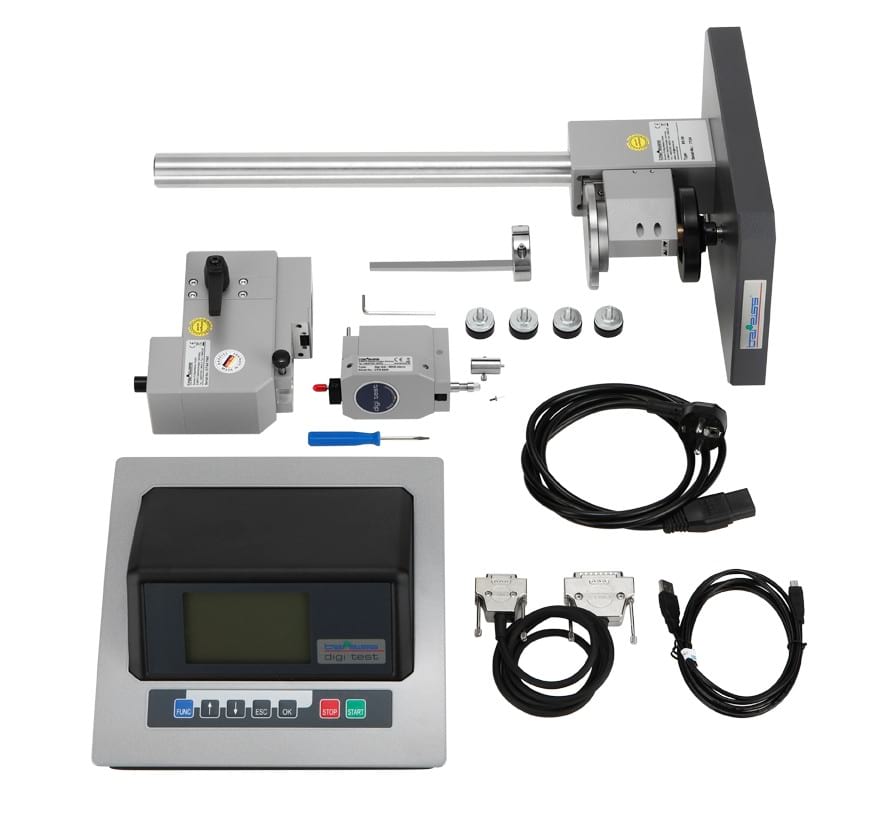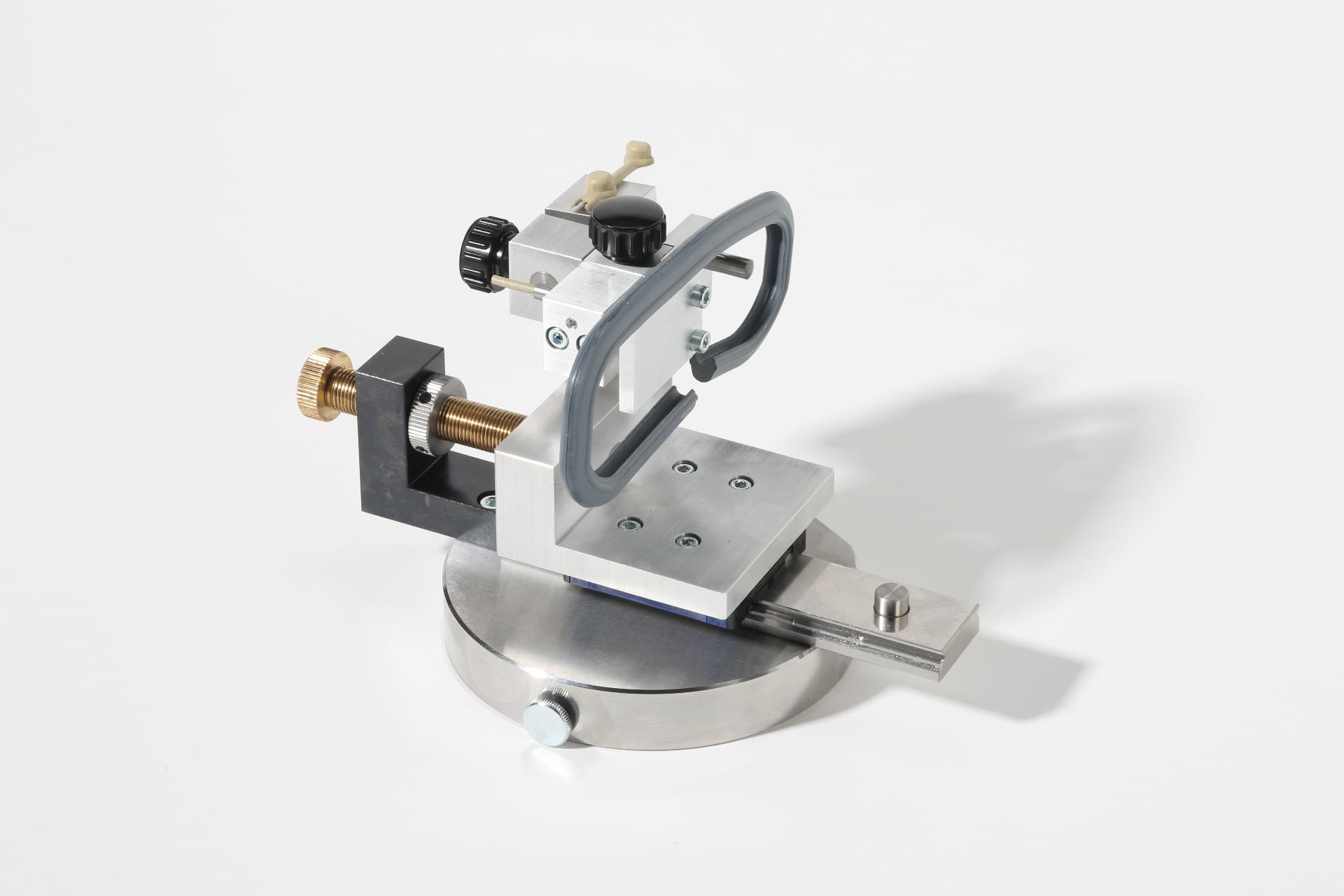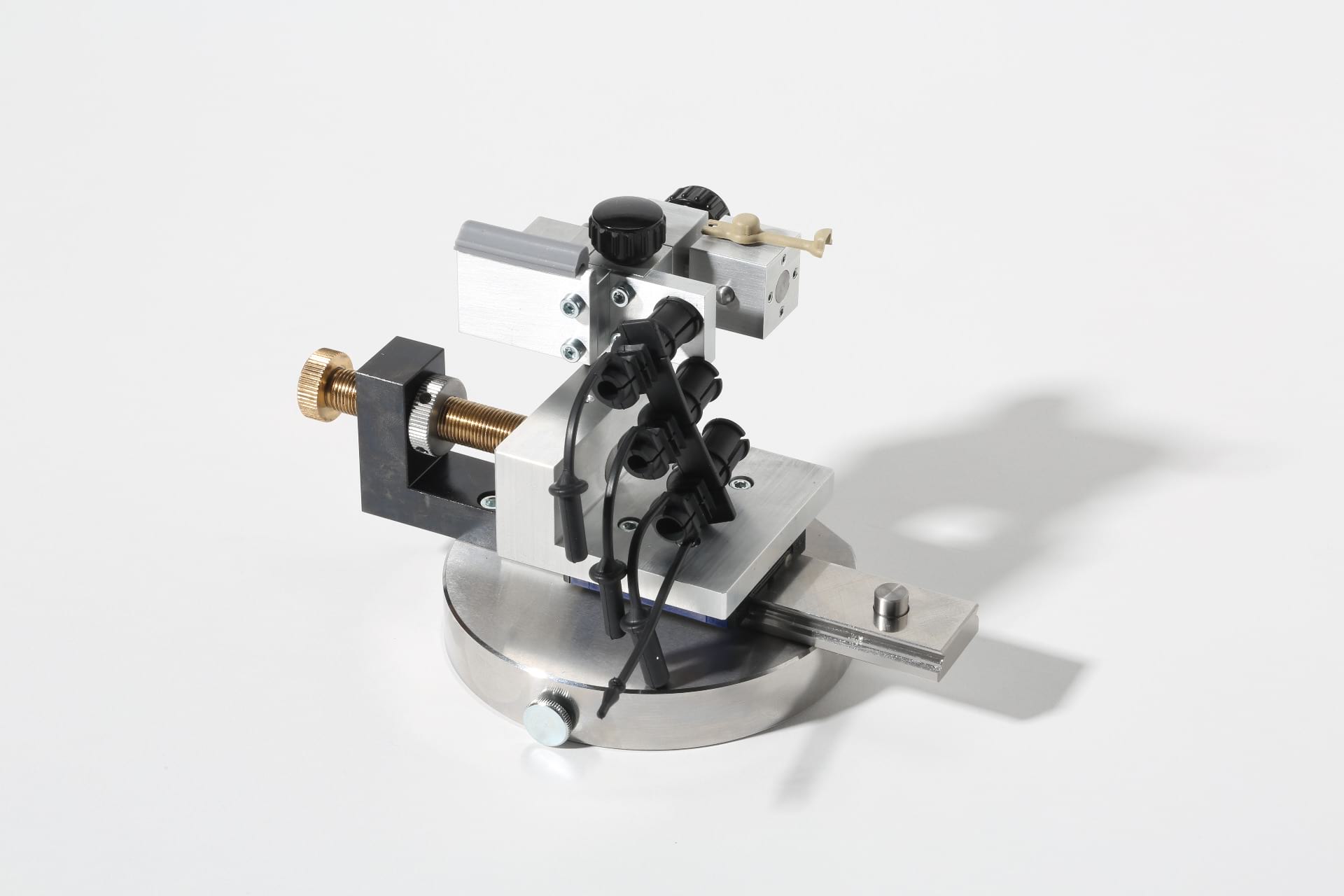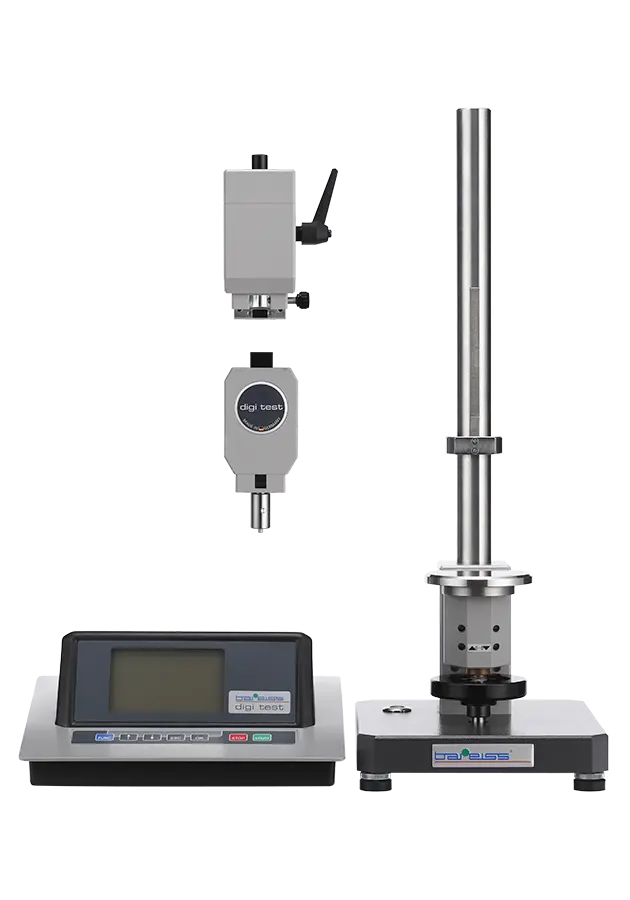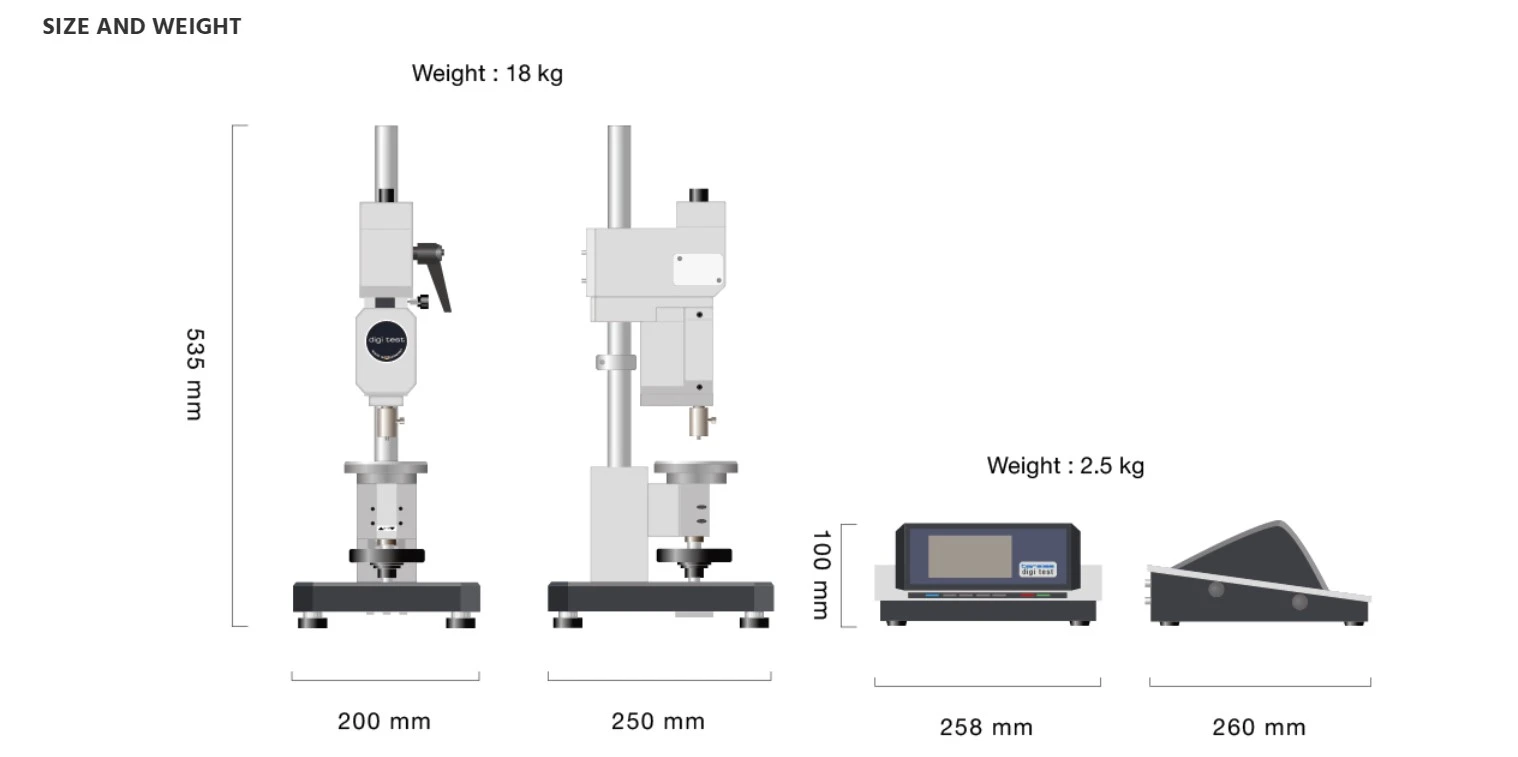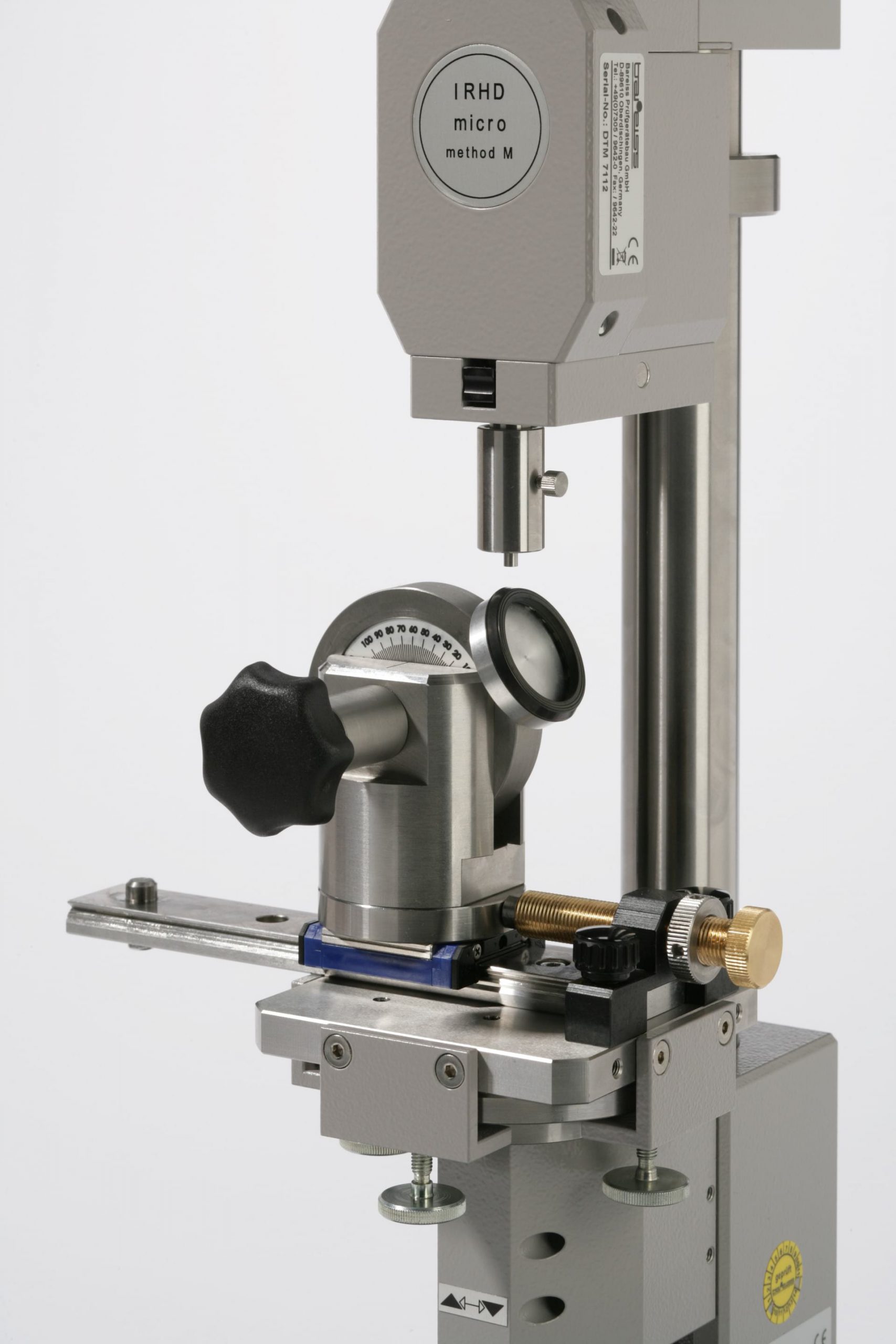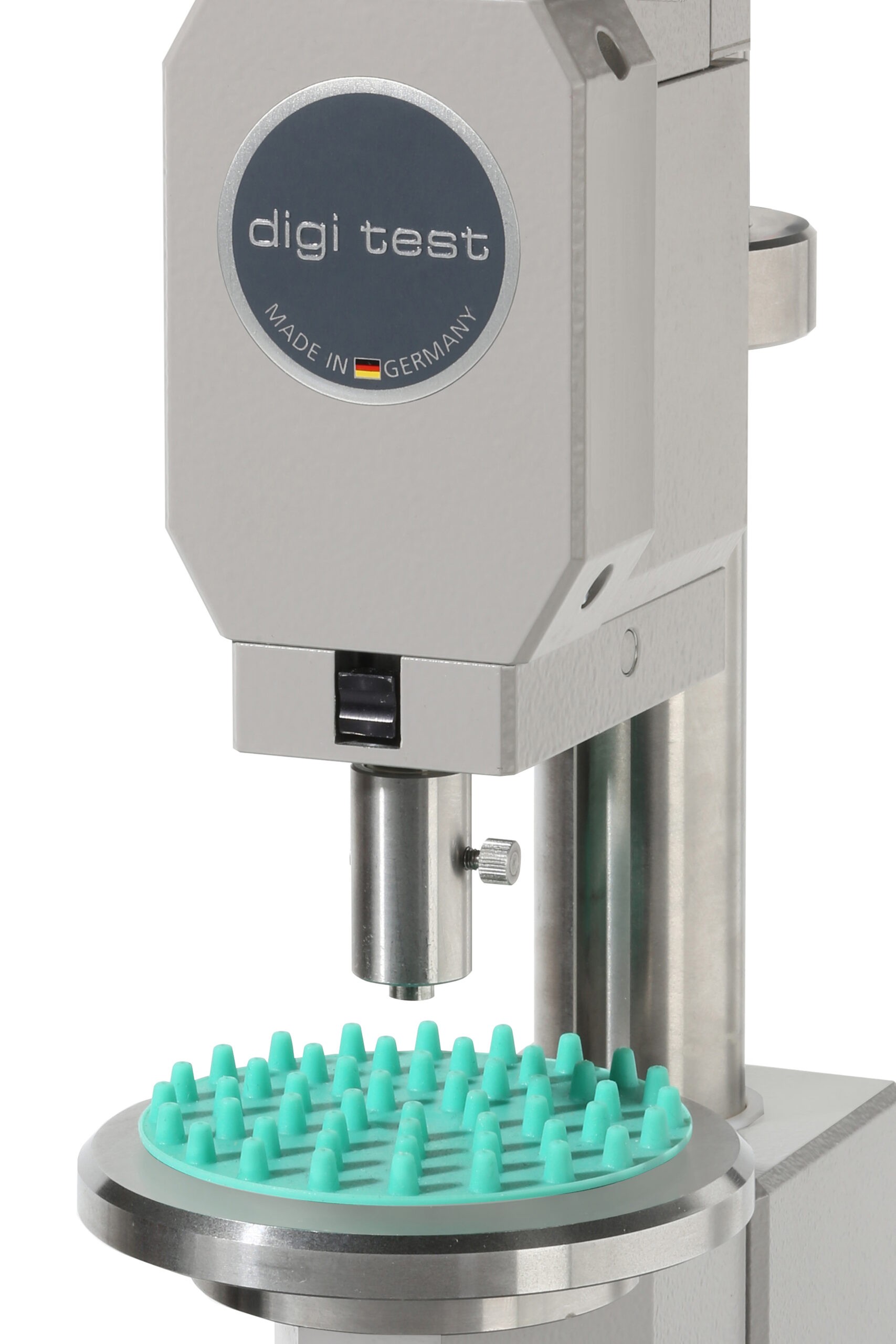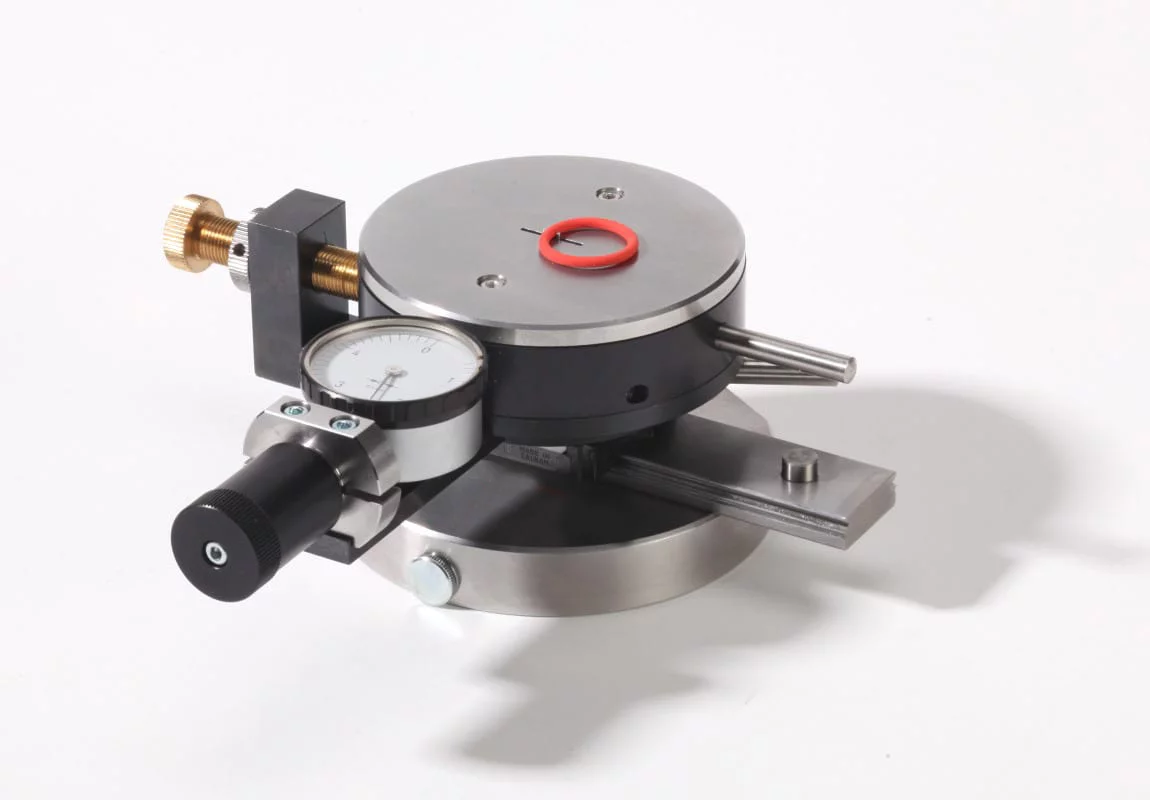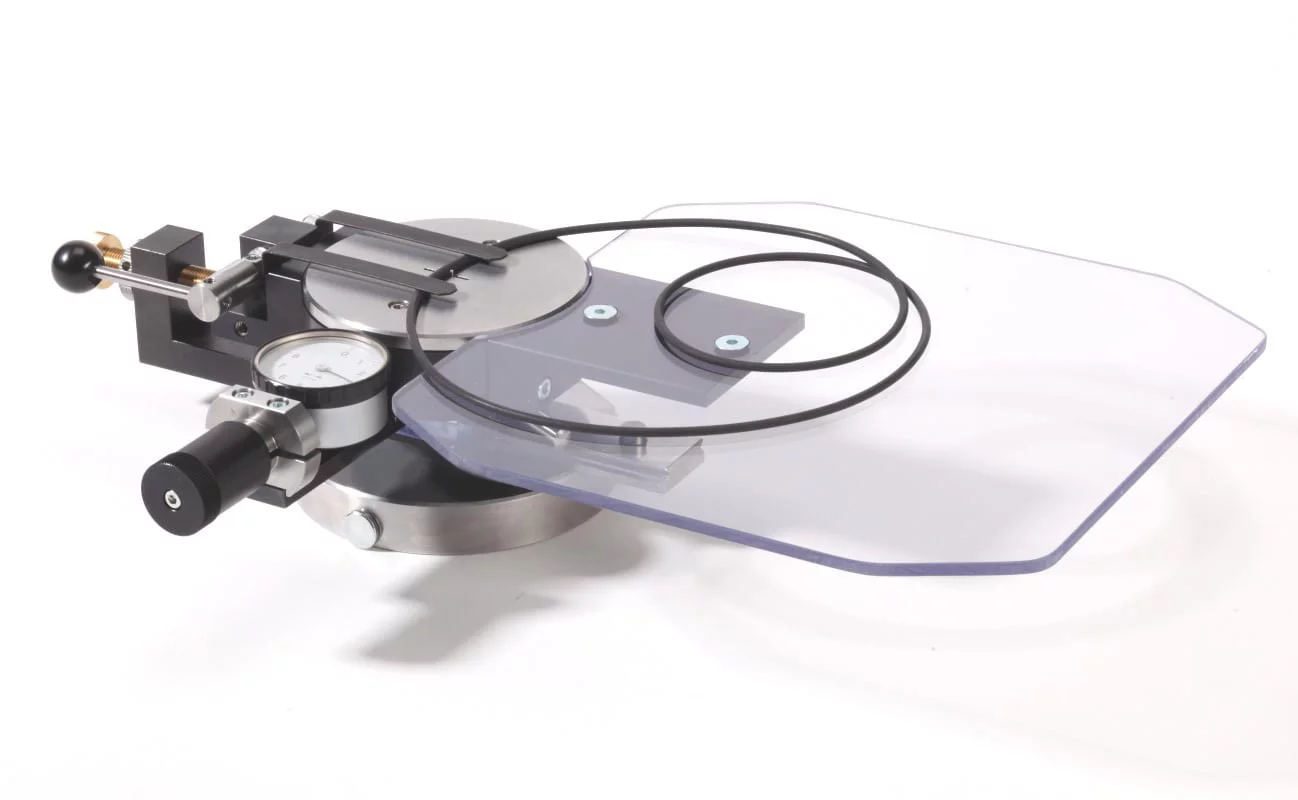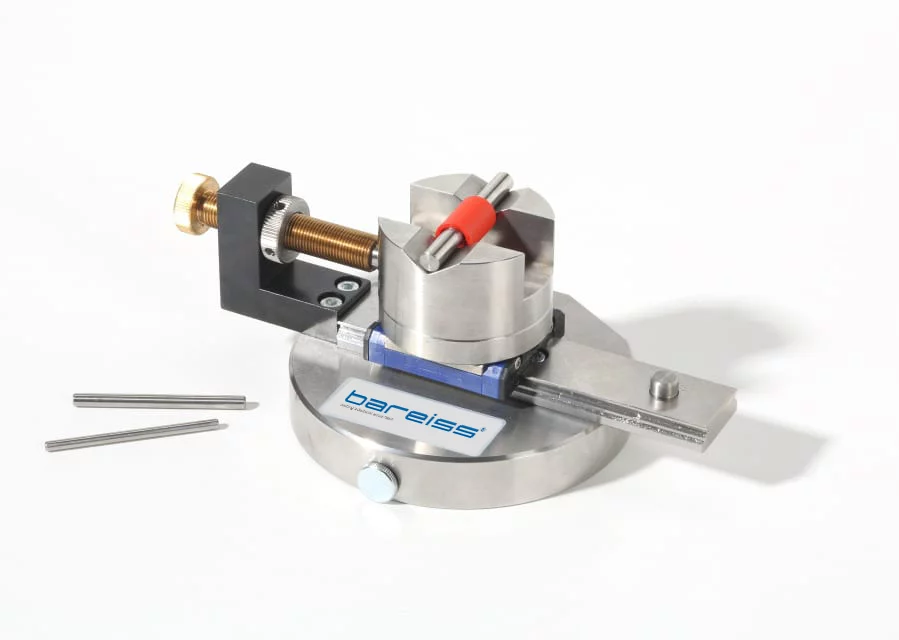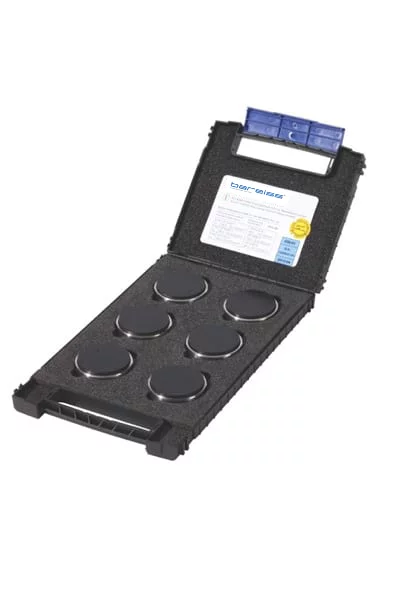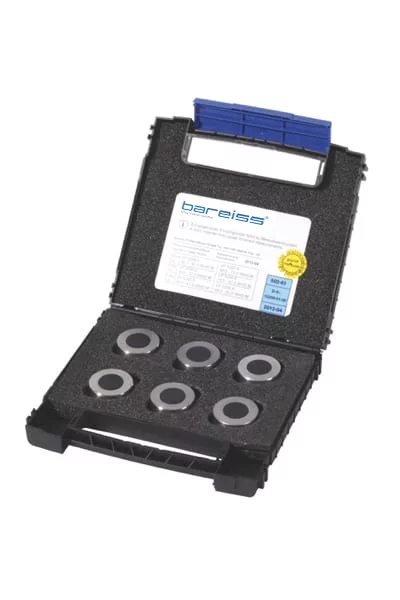Plastic Testing Equipment
Standards
DIN ISO 7619, DIN ISO 48, DIN EN ISO 868, NF EN ISO 868, ASTM D 2240, BS 903 Part. A 26, NF T 46-003, ASTM D1415, DIN ISO 27588



Certified



Description
Digi Test II is an automatic Shore, IRHD and VLRH hardness testing system. The unit comes equipment with 4 main components: Electronic unit, the loading module (pick-up bracket), the test stand, and the interchangeable measuring unit for methods of Shore, IRHD and VLRH.
The Digi Test II is a very smart device equipped with an electronic unit that functions as the main control for the display of user information, measurement of method and time, the selection of various features and the whole system. This automatic shore / IRHD system is a the preferred solution for automotive industry, rubber and plastic industry, defense and aerospace industry, and more.
Official DAkkS-Certificates
Offering official DKD/DAkkS-Certificates for the exchangeable measuring devices.


Features and Benefits
- Programmable measuring time, 1-99 sec
- Accuracy: 0.1 (1/10 of shore value)
- Compliance with ASTM D2240
- Electronic unit provides clear display of measured value, navigation menu and Data Output.
- Easy to use with limited operator influence to guarantee accurate and repeatable hardness test results every time.
- Reading in the display gives assistance for the correct selection of the measuring device during your measurement when the measured value is above or below the limit value.
- USB-interface for data transfer.
- Modular, digital hardness testing system.
- Interchangeable measuring units offering industry leading flexibility of testing to be performed on a single system.
- Automatic identification of the measuring range and of the measuring time.
- Integrable in an automatic production process.
- Hysteresis function
Hardness testing on concave and convex surfaces
Different from the usual hardness testers that can only measure flat-surfaced samples, the NextGen's digitest II measures hardness on every surface by making use of an automatic surface detection technology. Also the indenter length is customizable, making it extendable to any point on the sample that is to be measured.
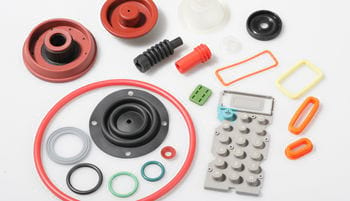
Sample holders and positioning devices
NextGen offers several standard sample holders however, we are committed to offering you customized holders that suits your product. Kindly contact the sales team for bespoke solutions. Down this page you will find some of the standard positioning devices for tubes and O-Rings.
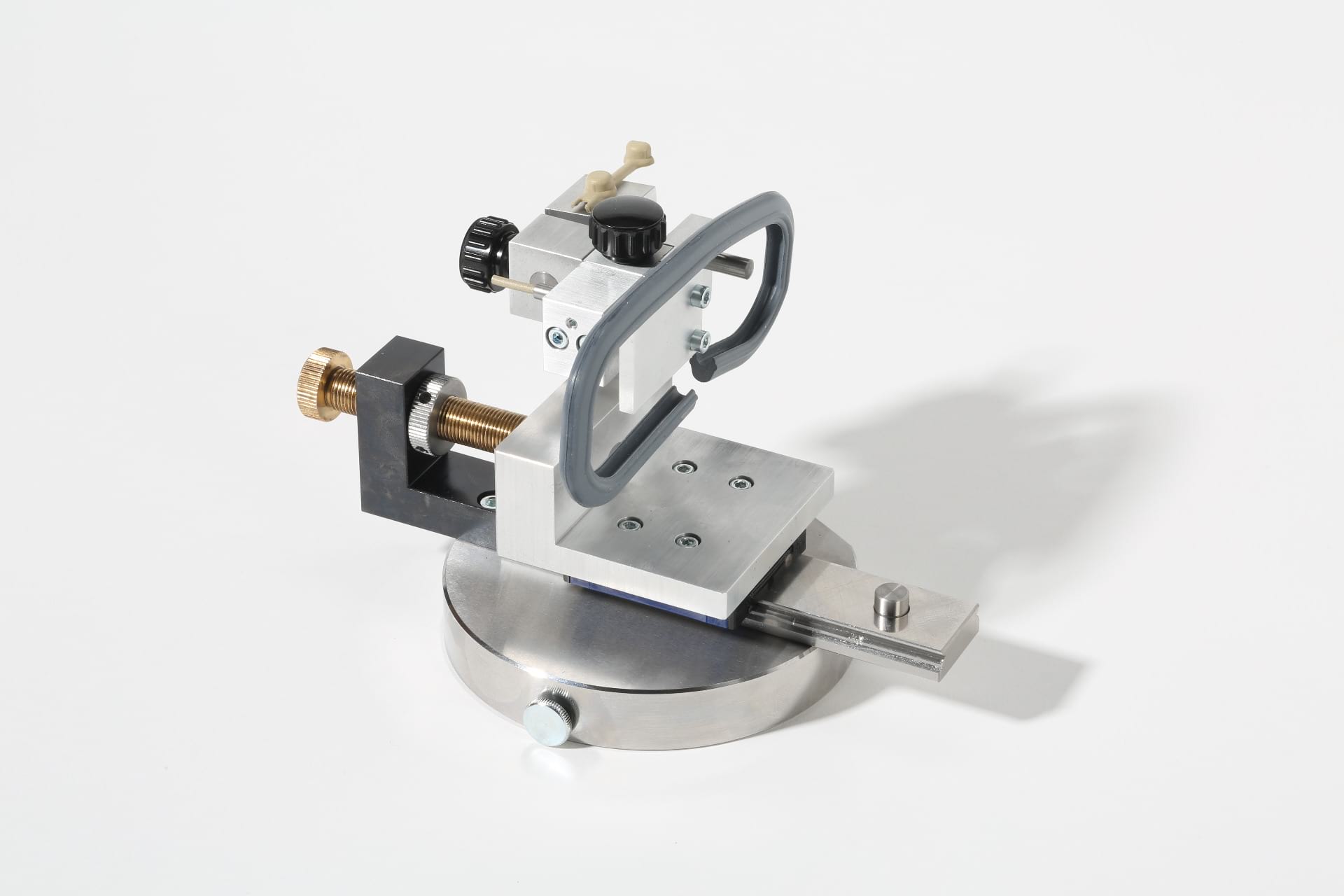
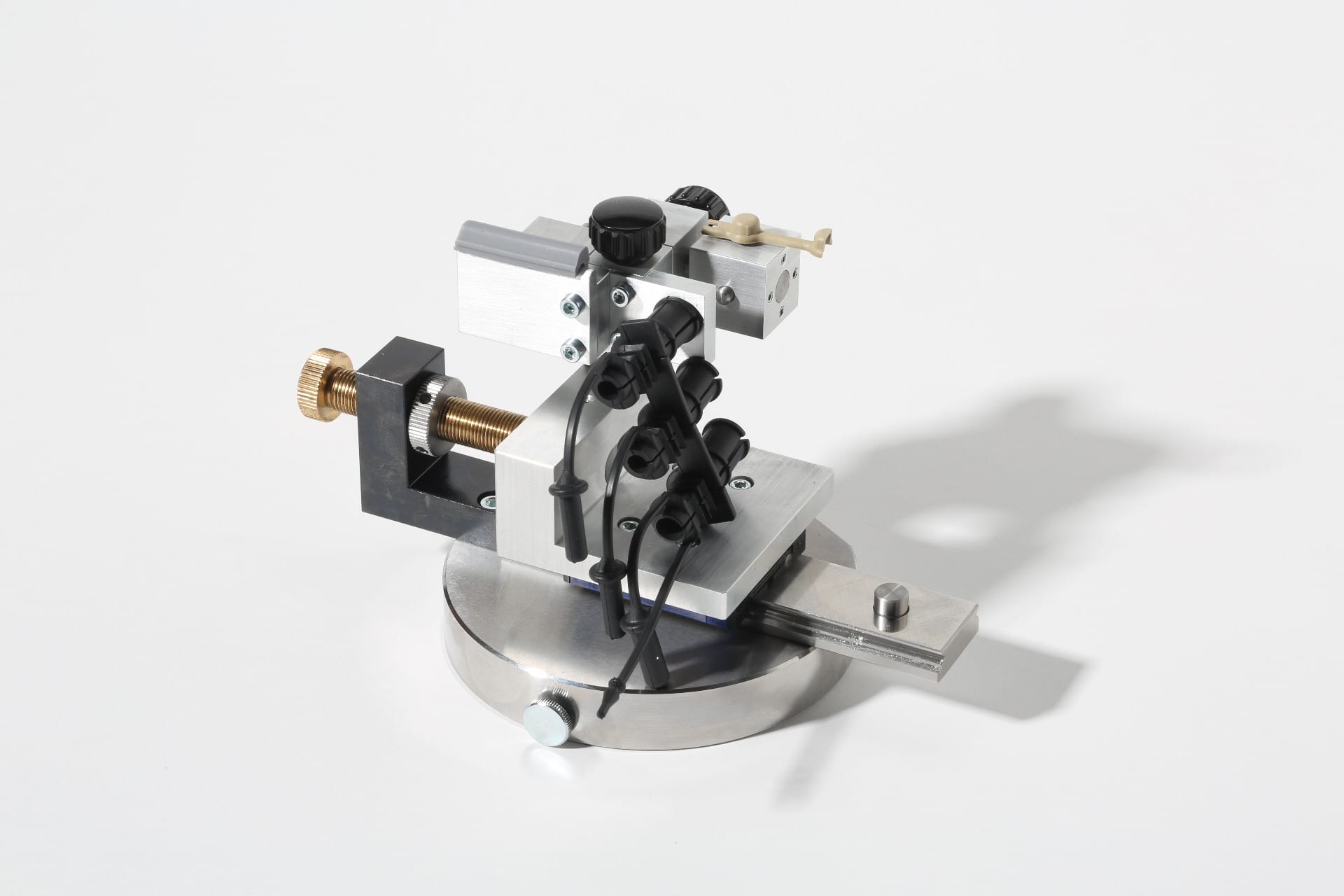
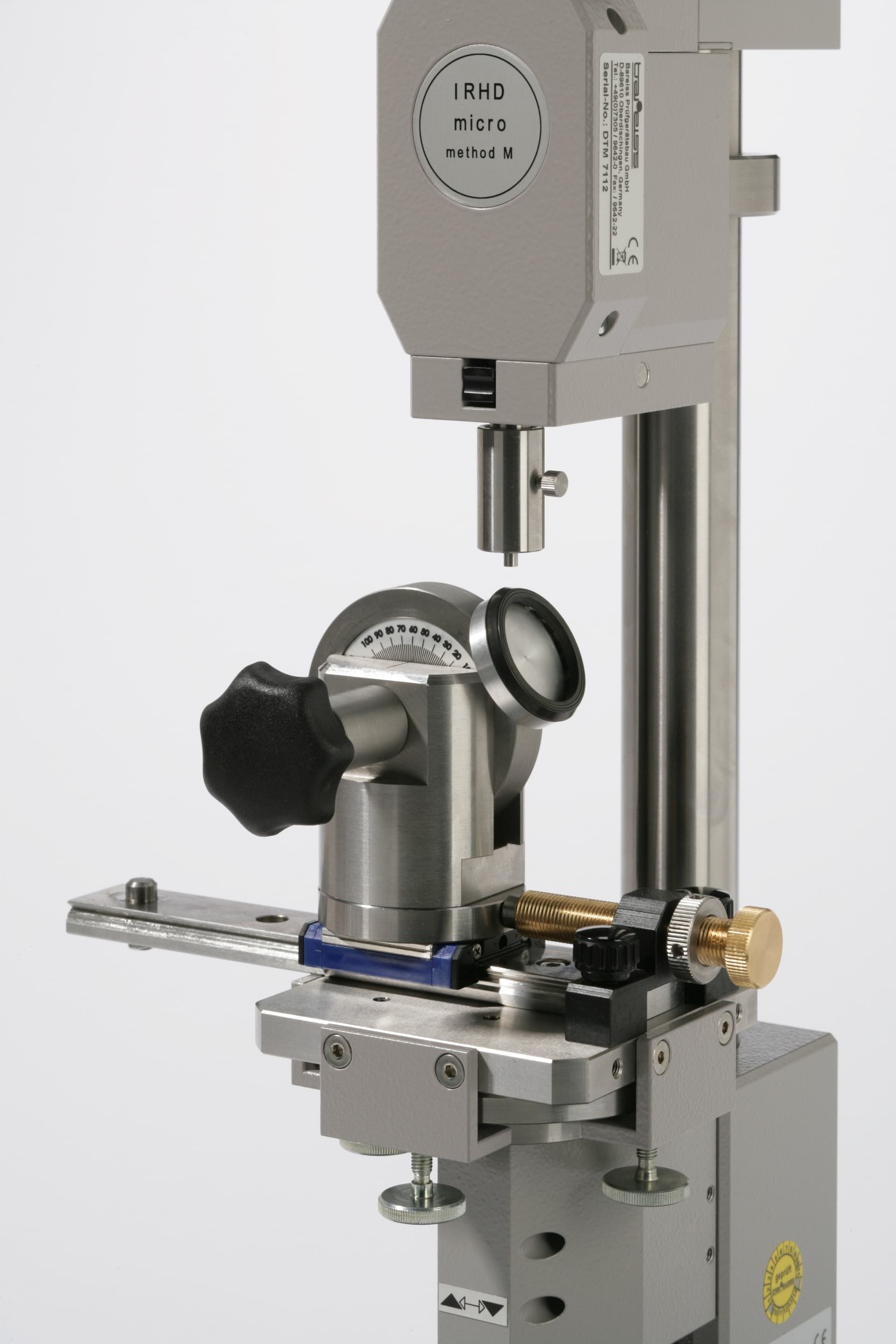
There is no need for setting up since it's a plug and play. To install the measuring unit, simply fasten the knurl nut, after this the electronic unit automatically detects the type of the installed method of measurement and time acc. to standards.
IRHD N/H/L
Suitable for plastically deformable materials from 6 up to 10 mm, highly elastic materials and soft rubbers.
IRHD L
Suitable for Hysteresis function from 10 up to 12 mm
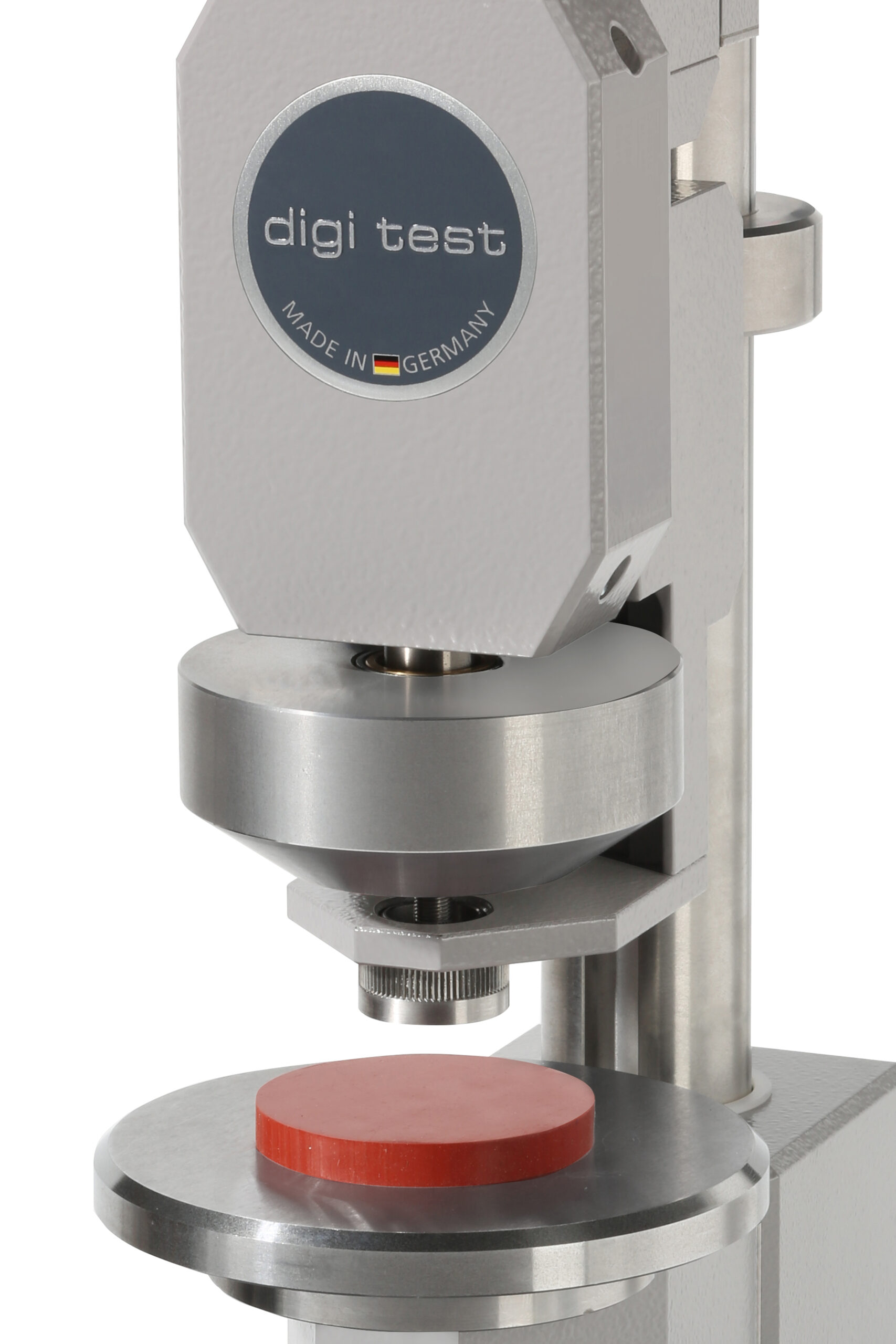
Shore 00/000
Suitable for foam rubber, silicone, sponge and cellular rubber, and gel like materials with material thickness of 6 mm Hysteresis function.
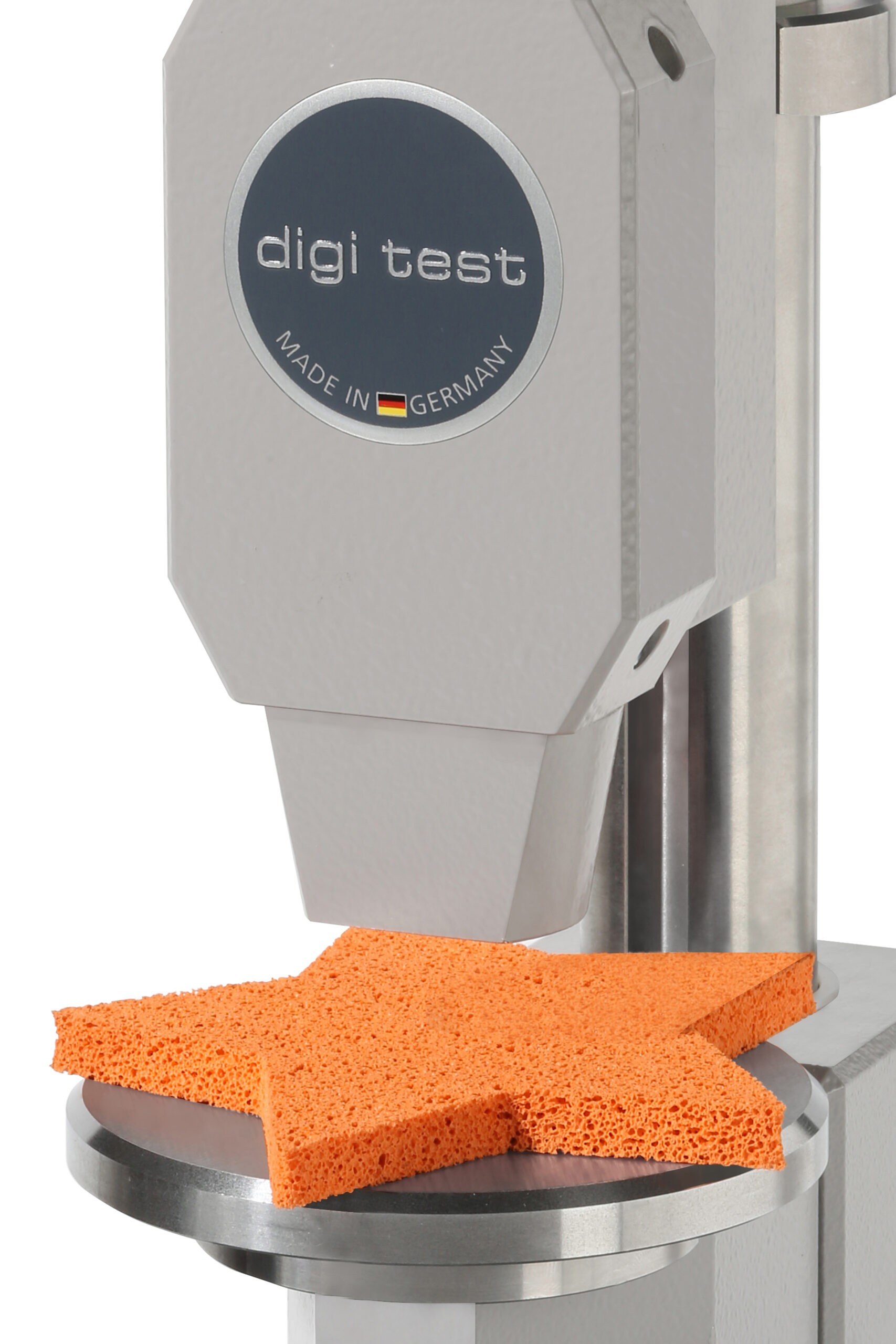
VLRH
Suitable for foam rubber, silicone, sponge and cellular rubber, and gel like materials with material thickness of 1 mm Hysteresis function.

Shore A/B/0
Suitable for convex and concave shaped parts of a material thickness of 4 or 6 mm
Micro Shore A
Suitable for materials with minimum material thickness of 1 mm
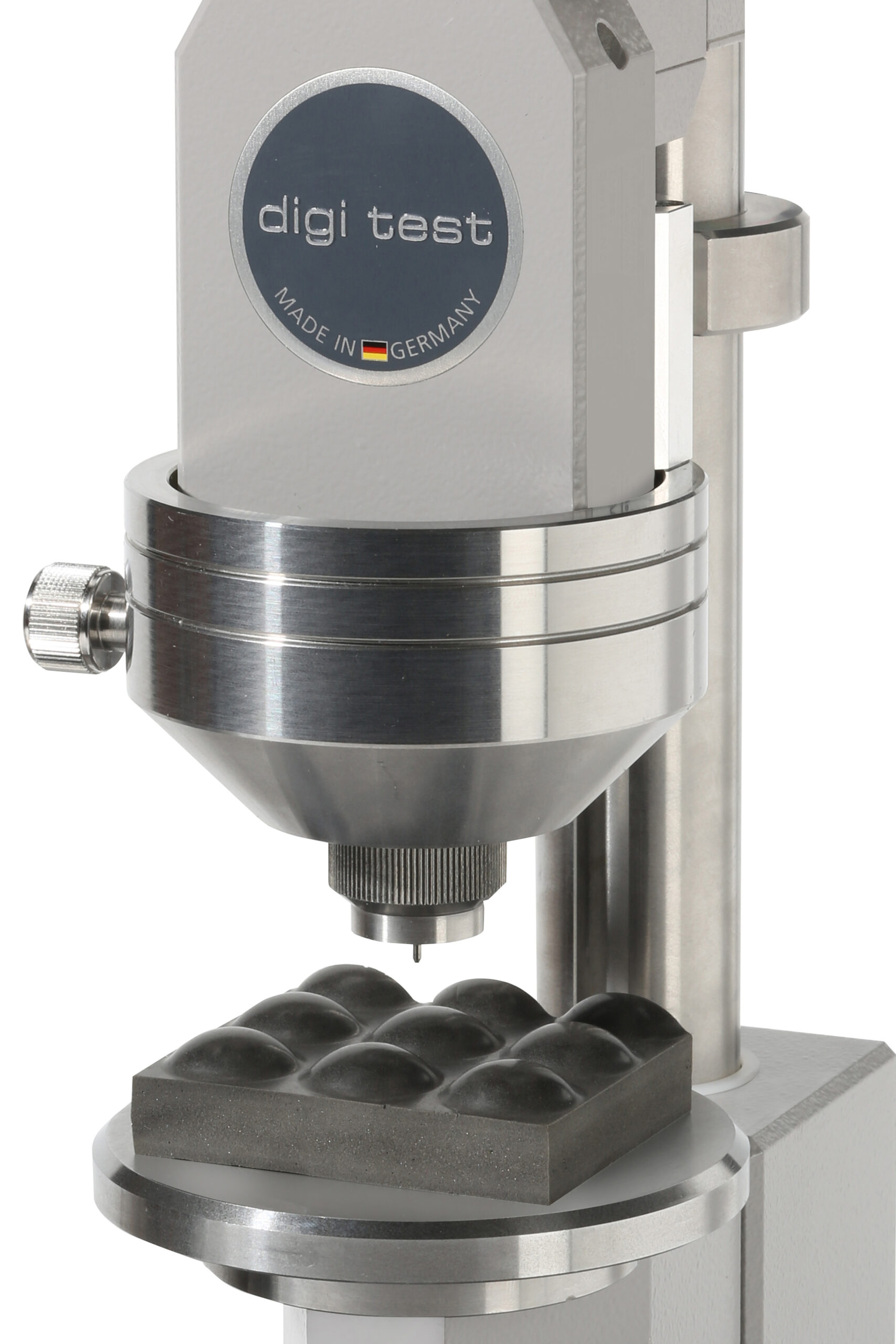
Shore D/C/D0
Suitable for shaped parts with thickness of up to 4 or 6 mm
Micro Shore D
Suitable for those with minimum thickness of 1 mm.
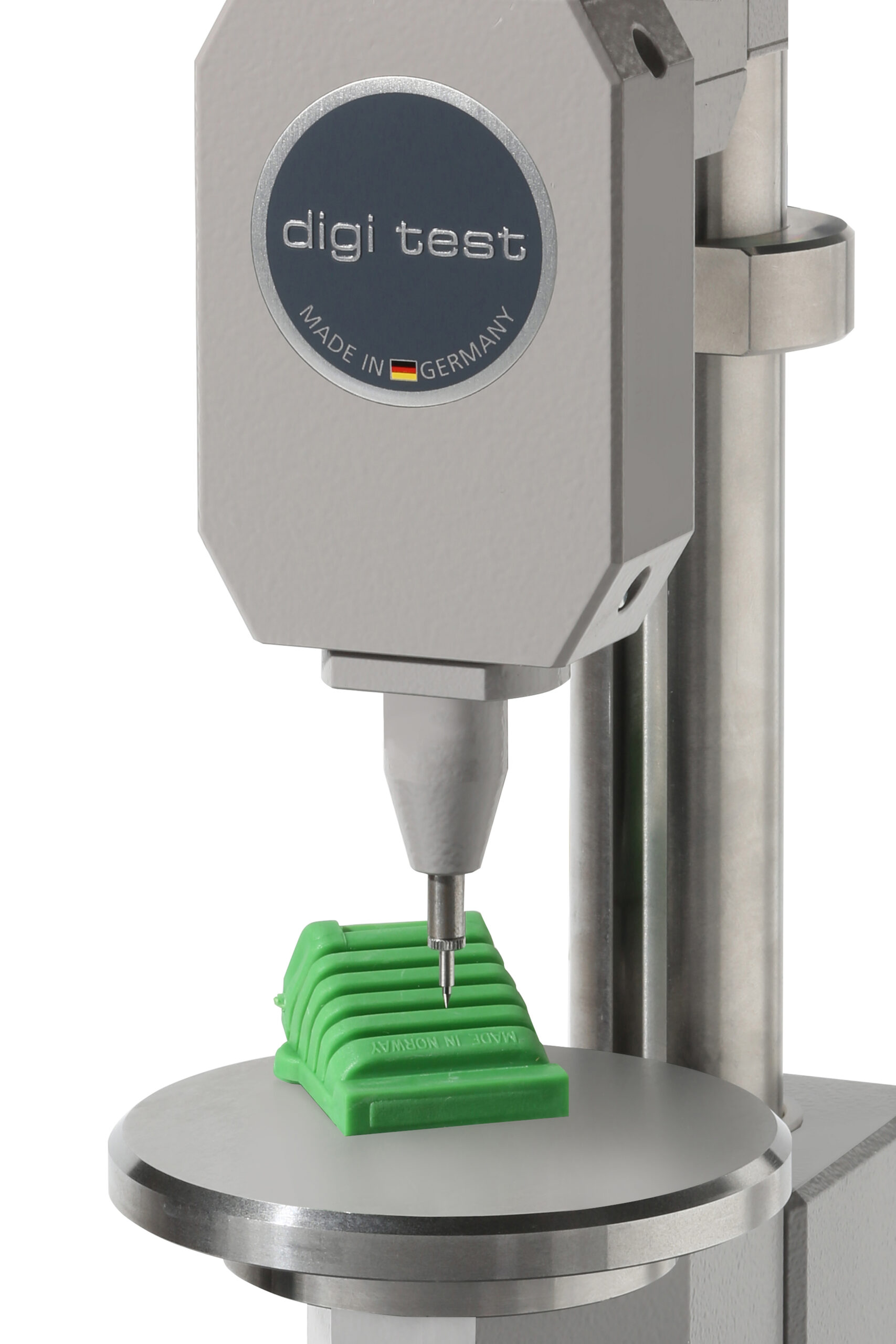
Automated O-Ring Measuring Device
Fully-automated laser measuring device for precise o-ring hardness testing
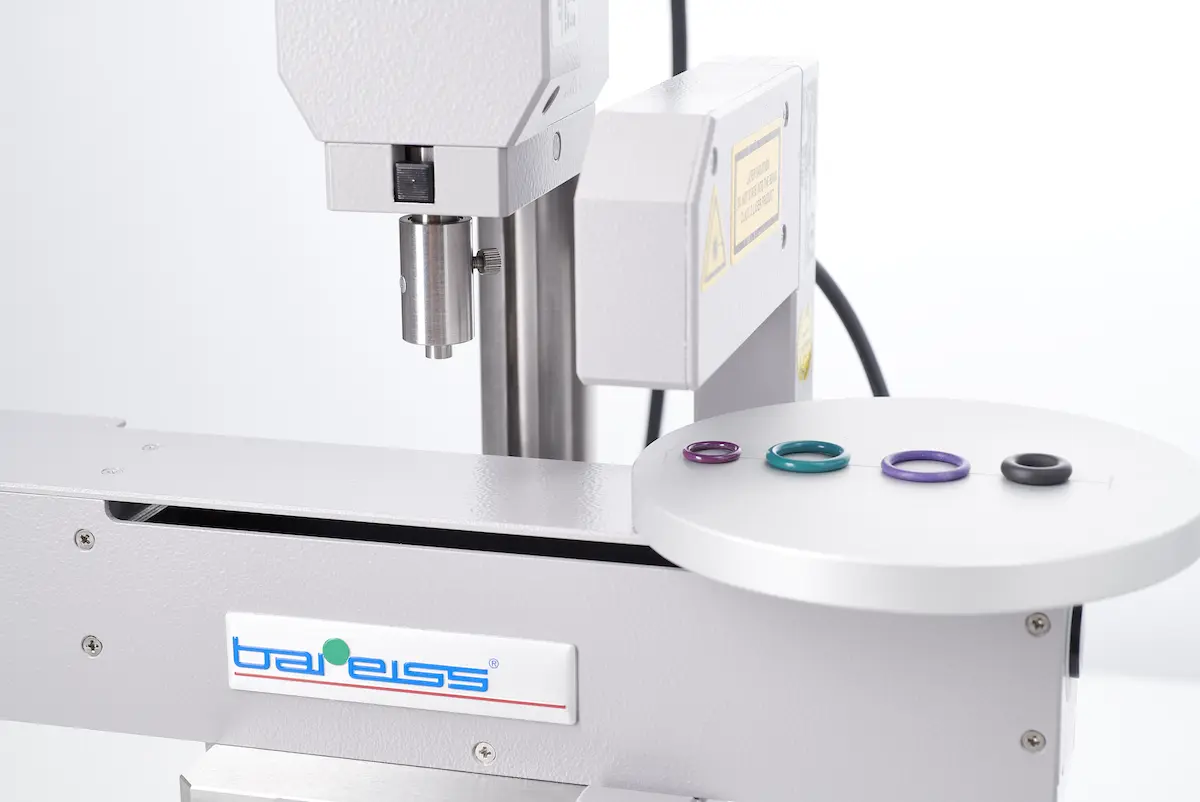
| Test Method | Range of Application | Standard | Minimum Material Thickness [mm] | Indenter [mm] |
|---|---|---|---|---|
| Shore A | soft rubber, elastomers, natural rubber products, neoprene, casting resin, polyester, soft PVC, leather, pressure rollers, etc ... |
DIN EN ISO 868 ------- DIN ISO 7619, ASTM D 2240, NFT 51-174, BS903 Part. A 26 |
4 ------- 6 |
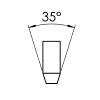 |
| Asker C | see Shore A | SRIS 0101, ABNT NBR 14455 |
6 | 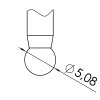 |
| Shore A0 | see Shore A | DIN ISO 7619 ASTM D 2240 |
6 |  |
| Shore A0 | see Shore A | DIN ISO 7619 ASTM D 2240 |
6 | 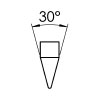 |
| Shore D | hard rubber, hard plastics, acrylic glass, polystyrene, rigid thermoplastics, Resopal, pressure rollers, Vinyl plates, cellulose- Acetate, etc ... |
DIN EN ISO 868 ------- DIN ISO 7619, ASTM D 2240, NFT 51-174, BS903 Part. A 26 |
4 ------- 6 |
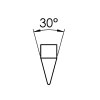 |
| Shore B | middle hard materials from rubber, typewriter roles, flat materials |
ASTM D 2240 | 6 | 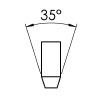 |
| Shore C | plastics and middle hard rubber materials |
ASTM D 2240 | 6 | 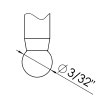 |
| Shore D0 | plastics and middle hard rubber materials |
ASTM D 2240 | 6 |  |
| Shore 0 | soft elastic materials, pressure rolls, middle firm, textile fabrics, nylon, orlon, perlon, rayon |
ASTM D 2240 | 6 | 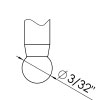 |
| Shore 00 | sponge- and foam rubber, cellular rubber, silicone |
ASTM D 2240 | 6 | 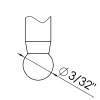 |
| Shore 000 | sponge- and foam rubber, cellular rubber, silicone |
ASTM D 2240 | 6 | 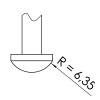 |
| Shore A0 Shore E</b > |
see Shore A | DIN ISO 7619 ASTM D 2240 |
6 | 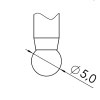 |
| Asker CS | see Shore D | SRIS 0101 | 6 | 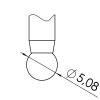 |
| Shore 000 S | see Shore 00 / 000 | ASTM D 2240 | 6 | 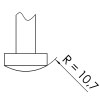 |
| Metal Hardness | ||||
| Barcol | fibre-glass reinforced plastics, thermosetting plastics, hard thermo-plastics, aluminum |
DIN EN 59, ASTM D 2583 |
1.5 | |
Barofix
This is a device for centering in O-Rings with outer diameter of 200mm and cord diameter falling between 0,6 to 5,0 mm.
Comes with a sample clamping device and plexiglas plate of 200 x 200 mm dimension.
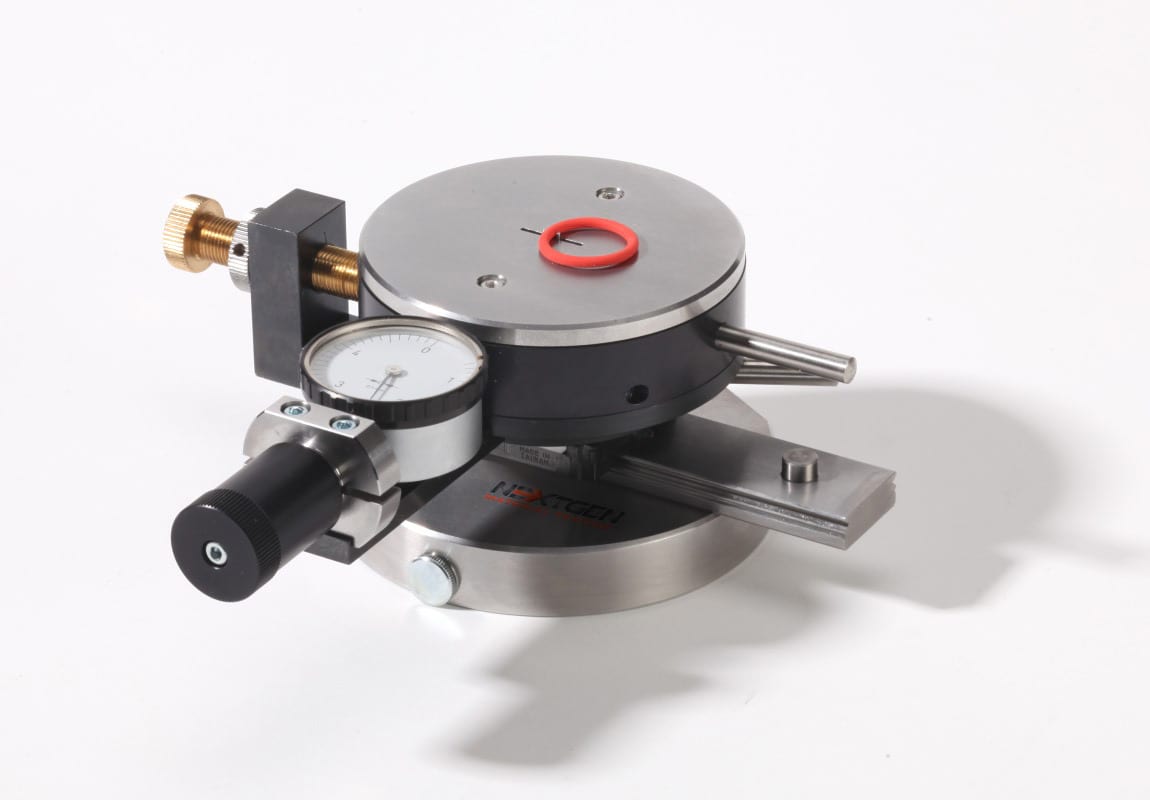
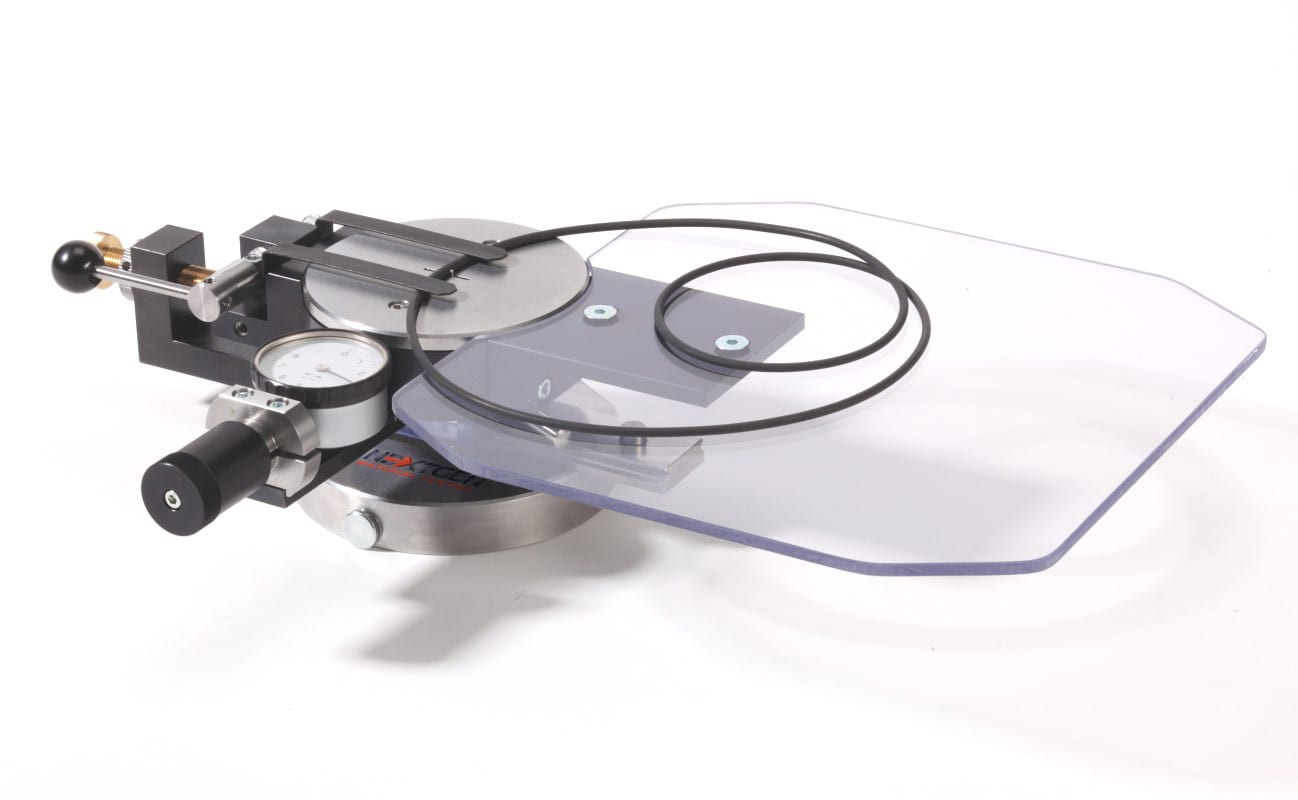
Barofix II/Barofix III/Barofix IV
Automatic centering device for fast centering of O-rings to enable a reduction in the influence of operators.
Compatible with only digi test II. Read more about the latest Barofix 4 Centering Device in our blog!

Centrofix
Centering device for speedy centering of hose or rubber tubes.
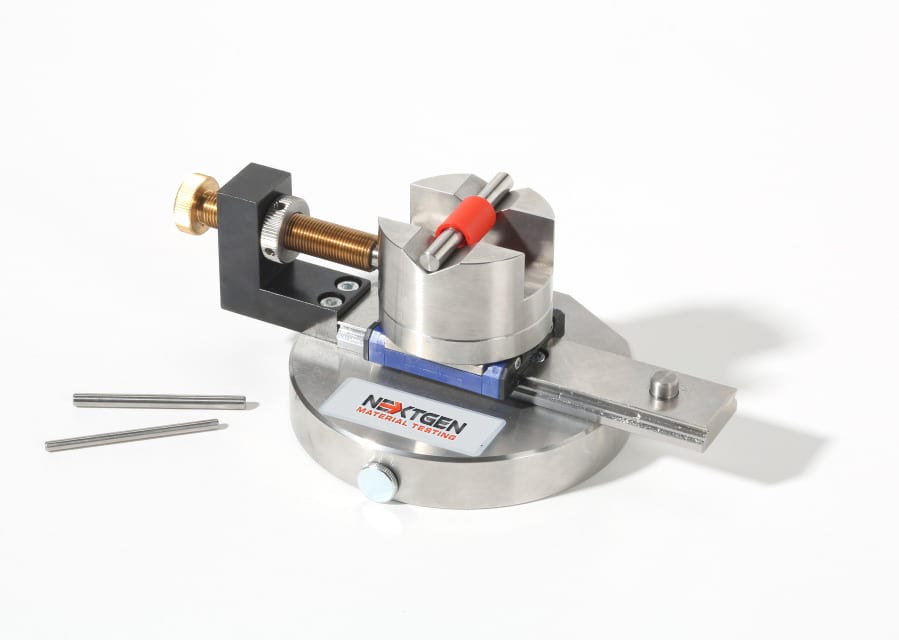
Centrofix for Oil Seals
Centering device that makes measurement possible at every part of the oil seal.
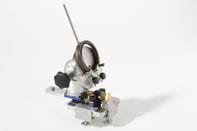
Reference plates
Due to possible frequent recalibration standard rubber blocks are used to maintain the metrological capability of the measuring device account to IRHD. The rubber blocks are embedded in a stainless steel holder.
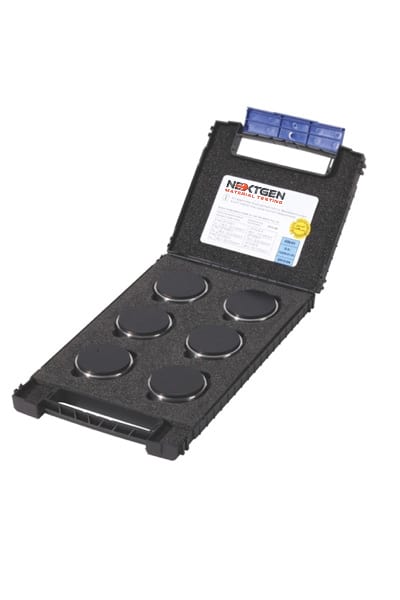
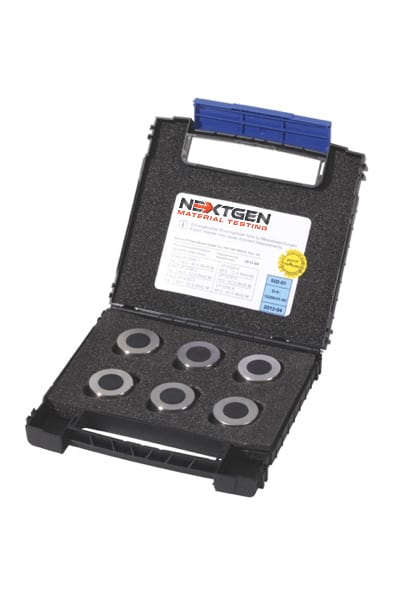
Hardtest - the test - and evaluation software program
Can be applied on every NextGen testing devices that has a serial interface. Every function needed for a fault free process is embedded in the program.
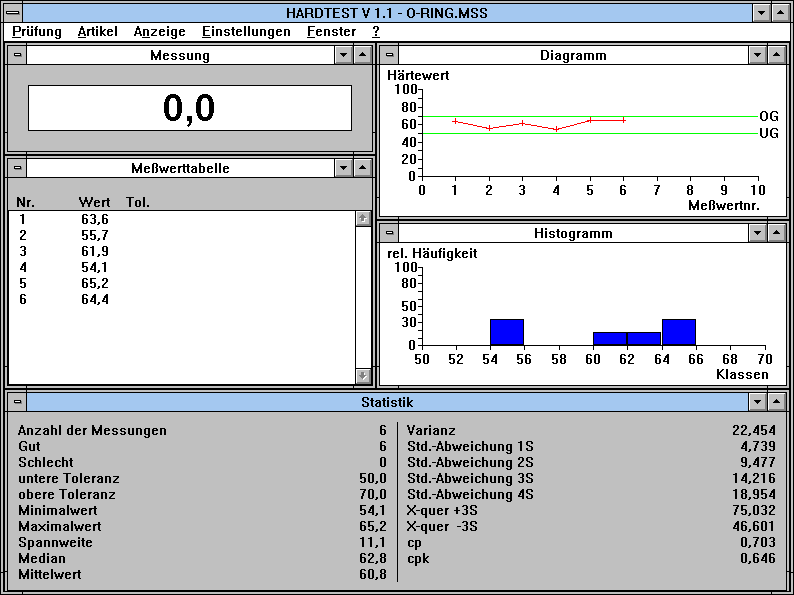
DAkkS/DKD calibration certificate
Several measurements and standard references are used to determine the given deviation during the calibration of a measuring instrument. After this, a calibration certificate will be issued showing the measuring results and the resulting measurement uncertainties is ticked as calibrated.
The calibration certificate as well as all the documents reflects the national standards.
Rubber - and plastics hardness
| Test.Method | Range of Application | Standards | Min.Thickness |
|---|---|---|---|
| Shore A | soft rubber, elastomers, DIN EN ISO 868 4 natural rubber products, neoprene, casting resin, polyester, soft PVC, leather, pressure rollers, etc... | DIN EN ISO 868 | 4 mm |
| Shore A | soft rubber, elastomers, DIN EN ISO 868 4 natural rubber products, neoprene, casting resin, polyester, soft PVC, leather, pressure rollers, etc... | DIN ISO 7619, DIN 53505, ASTM D 2240, NFT 51-174, BS903 Part. A 26 | 6 mm |
| Asker C | soft rubber, elastomers, DIN EN ISO 868 4 natural rubber products, neoprene, casting resin, polyester, soft PVC, leather, pressure rollers, etc... | SRIS 0101, ABNT NBR 14455 | 6 mm |
| Shore A0 Shore E |
soft rubber, elastomers, DIN EN ISO 868 4 natural rubber products, neoprene, casting resin, polyester, soft PVC, leather, pressure rollers, etc... | DIN ISO 7619 ASTM D 2240 | 6 mm |
| M Shore A | soft rubber, elastomers, DIN EN ISO 868 4 natural rubber products, neoprene, casting resin, polyester, soft PVC, leather, pressure rollers, etc... | Bareiss standard | 0,5 mm |
| Shore D | hard rubber, hard DIN EN ISO 868 4 plastics, acrylic glass, polystyrene, rigid thermoplastics, Resopal, pressure rollers, Vinyl plates, cellulose-Acetate, etc... | DIN EN ISO 868 | 4 mm |
| Shore D | hard rubber, hard DIN EN ISO 868 4 plastics, acrylic glass, polystyrene, rigid thermoplastics, Resopal, pressure rollers, Vinyl plates, cellulose-Acetate, etc... | DIN ISO 7619, ASTM D 2240, NFT 51-174, BS903 Part. A 26 | 6 mm |
| Asker CS | see Shore D | SRIS 0101 | 6 mm |
| M Shore D/C/D0 | see Shore D 0,5 | Bareiss standard | 1,5 mm |
| M Shore D/C/D0 | see Shore D 0,2 | Bareiss standard | 1,5 mm |
| Shore B | middle hard materials from rubber, typewriter roles, flat materials | ASTM D 2240 | 6 mm |
| Shore C | plastics and middle hard rubber materials | ASTM D 2240 | 6 mm |
| Shore D0 | plastics and middle hard rubber materials | ASTM D 2240 | 6 mm |
| Shore 0 | soft elastic materials, pressure rolls, middle firm, textile fabrics, nylon, orlon, perlon, rayon | ASTM D 2240 | 6 mm |
| Shore 00 | sponge- and foam rubber, cellular rubber, silicone | ASTM D 2240 | 6 mm |
| Shore 000 | sponge- and foam rubber, cellular rubber, silicone | ASTM D 2240 | 6 mm |
| Shore 000 S | see Shore 00 / 000 | ASTM D 2240 | 6 mm |
| Type AM/M | see Shore A | DIN ISO 7619 ASTM D 2240 | 1,5 mm |
| IRHD M | thin walled O-rings, moulded parts, standard plates | DIN ISO 48, ASTM D 1415, NFT 46-003, BS903 Part. A 26 | 0,6 mm |
| IRHD H | see Shore D | DIN ISO 48, ASTM D 1415, NFT 46-003, BS903 Part. A 26 | 6 mm |
| IRHD N | soft rubber, high elastic materials, plastic ductile materials | DIN ISO 48, ASTM D 1415, NFT 46-003, BS903 Part. A 26 | 6 mm |
| IRHD L | sponge- and foam rubber, cellular rubber, silicone | DIN ISO 48, ASTM D 1415, NFT 46-003, BS903 Part. A 26 | 10 mm |
| VLRH | sponge- and foam rubber, cellular rubber, silicone | DIN ISO 27588 | 2 mm |
| Pusey & Jones | rubber- or rubberlike materials, rubber rollers for the paper industry | ISO 7267-3, ASTM D 531 | 13 mm |
Services we offer:
- Testing Service
- Calibration Service
- Training
- Testing devices on loan during recalibration
- Maintenance Contract
FAQs
Yes, hysteresis measurements can be used to determine the durability of a material. Hysteresis measures the energy lost during deformation and recovery, which can be directly related to the material's ability to withstand repeated loading and unloading cycles. Therefore, a material with low hysteresis and high elastic recovery is generally considered to be more durable than one with high hysteresis and low elastic recovery.
In rubber and plastic hardness testing, hysteresis measurements can be used to evaluate the durability of materials under various loading conditions, including fatigue and creep. Fatigue testing involves subjecting the material to cyclic loading until it fails, while creep testing measures the material's deformation over time under a constant load. Both types of testing can provide insights into the material's durability and its ability to maintain its mechanical properties over time.
In addition, hysteresis measurements can be used to assess the effectiveness of material modifications or treatments designed to improve durability. For example, a material that has been modified to reduce hysteresis and increase elastic recovery may be expected to have better long-term durability than an unmodified material.
NextGen’s Digitest II is the industry leading Shore and IRHD hardness tester capable of doing Hysteresis and will be very useful for rubber manufacturers.
Click here to learn more about the product or here to receive a personalized quote.
Hysteresis is a well-known phenomenon in materials science, where a material's response to a stimulus depends on its previous history. In the context of rubber and plastic hardness testing, hysteresis refers to the energy loss that occurs when a material is subjected to cyclic stress or strain. This energy loss is represented by a hysteresis loop, which depicts the difference between the energy input and output during the deformation and recovery process.
Hysteresis can significantly impact the measurement of a material's hardness and elasticity in rubber and plastic hardness testing. Under cyclic loading, the material undergoes repeated deformation and recovery, decreasing its stiffness and hardness over time, particularly in materials that experience repeated loading and unloading cycles, such as those used in engineering applications.
To account for hysteresis in rubber and plastic hardness testing, you need to consider the material's dynamic properties, such as its storage and loss modulus, representing its ability to store and dissipate energy. These properties can be measured using sophisticated equipment, such as a dynamic mechanical analyzer (DMA). They can be utilized to quantify the material's hysteresis and predict its behaviour under various loading conditions.
NextGen’s Digitest II is the industry leading Shore and IRHD hardness tester capable of doing Hysteresis and will be very useful for rubber manufacturers.
Click here to learn more about the product or here to receive a personalized quote.
Hysteresis and elasticity are two key properties of materials that are closely related to each other. Elasticity is the ability of a material to deform under stress and return to its original shape once the stress is removed. Hysteresis, on the other hand, is the energy lost during the deformation and recovery process.
In materials with high elasticity, such as rubber or some types of plastics, the deformation under stress is reversible and the material returns to its original shape with minimal energy loss. But, materials with low elasticity, such as metals, have a more permanent deformation under stress and a higher energy loss during the recovery process.
Hysteresis affects the elasticity of a material by reducing its ability to store and recover energy. The energy lost during the deformation and recovery process can decrease the material's elasticity over time. This effect is particularly pronounced in materials that undergo cyclic loading, where the energy loss accumulates with each cycle.
NextGen’s Digitest II is the industry leading Shore and IRHD hardness tester capable of doing Hysteresis and will be very useful for rubber manufacturers.
Click here to learn more about the product or here to receive a personalized quote.
Hysteresis is the phenomenon where the response of a material to a stimulus depends not only on the magnitude of the stimulus but also on the history of the material.
Static Hysteresis occurs when a material is subjected to cyclic stress or strain at a constant rate. The deformation of the material during each cycle is proportional to the stress or pressure applied, and the material returns to its original shape once the stress or strain is removed. However, the material does not follow the same path during the unloading phase as during the loading phase, resulting in a hysteresis loop. This loop represents the energy loss during the deformation and recovery process.
Dynamic Hysteresis occurs when a material is subjected to cyclic stress or strain at a varying rate. Hence, the material's response depends on the stimulus's frequency and amplitude. As the frequency increases, the material's ability to dissipate energy decreases, resulting in a smaller hysteresis loop.
NextGen’s Digitest II is the industry leading Shore and IRHD hardness tester capable of doing Hysteresis and will be very useful for rubber manufacturers.
Click here to learn more about the product or here to receive a personalized quote.
The VLRH (Very Low Rubber Hardness) testing scale is unique to the DigiTest II system. It follows the DIN ISO 27588 principle and is typically used for thin sponge-like material including: sponge- and foam rubber, cellular rubber, silicone, etc. The primary differences between the scales is that the VLRH can do indentations on thinner specimens of 2mm. It is kind of like a Micro Test Head for Shore 00 and 000, except that it offers added versatility of being able to test on concave and convex surfaces.
The measuring ranges are comparable based on their corresponding standards ASTM D2240 (Shore 00/000) and DIN ISO 27588 (VLRH).
Normally, the calibration of shore hardness tester takes place annually, however this may vary based on your laboratory requirements. Some of our customers wait a few years before official calibration of their shore hardness testing heads because the unit still provides the exact same reading as the certified test blocks.
Provided you require calibration, you will have two options:
Option #1: Shipping Your Unit to NextGen
It is important to note that you do not need to ship the entire unit back to us for calibration. All that is required are the Shore/IRHD test heads.
Simply reach out to us at [email protected] and please provide your serial number. We will offer the instructions to you.
Option #2: Loaner Program during Calibration
In order to avoid any production interruptions, we provide a loaner program option. This allows you to continue testing while your equipment is being calibrated. NextGen will send you 'loaner' calibrated test heads before you send yours out to us!
Here is what you do:
STEP 1:
Please provide details on the measuring head(s) you wish to have evaluated, calibrated and certified. We recommend doing this 45-60 days before the required calibration time.
Please provide the serial No. of the machine.
You may send request by e-mail to [email protected]
STEP 2:
NextGen will outline the estimate for the loaner, the cost of a calibration service and the turnaround time. We will additionally offer all the shipping and logistics instructions for your convenience.
STEP 3:
Follow our instruction from step 2!
Should you have any further questions or require additional clarification, feel free to call us to speak with a qualified representative.
With the correct accessories, your Digi-test can absolutely double as an IRHD hardness tester.
For Shore D testing, a complete system includes the electronic unit and interface, a pick-up bracket with loading device, the Shore D measuring device, the indenter, the additional loading weights and any required certificates required to maintain your records.
With some additional sample holders such as the Barofix or Centrofix, measuring O-rings has never been more simple!
The Digi-test is commonly found in the rubber and plastics processing industries, automotive, chemical, cosmetics, food, aerospace, research centers and institutes, pharmaceuticals, medical technologies and optical industries.
Besides Shore A, the Digi-test with separate accessories can test Shore scales A, A0, B, 0, C, D, D0, 00, 000, 000 S, E, micro Shore A, micro Shore D, C, D0, IRHD/DIDC M, N, H, L, and VLRH.
The Digi-Test can accurately test Shore A as well as Micro Shore A. Shore A is designed for concave and convex molded parts of a material thickness of 4 to 6 millimeter. Micro Shore A is beneficial for those samples with a minimum thickness of 1mm.
The Digi-Test can test Shore D for measuring hard rubbers, semi rigid plastics and hard plastics. It also has the function of micro Shore D testing for samples with a minimum thickness of 1mm.
The Digi-test is commonly used for testing flexible mold rubbers that range in hardness from very soft and flexible through to hard materials with limited flexibility.
With Shore D, the recommended thickness of parts is 4 to 6 millimeter as it applies a very heavy load while measuring resistance to indentation.
The Digi-Test is a complete all in one solution, removing all human elements from your testing results, to provide the highest accuracy in quality assurance.
Shore hardness testing equipment is designed to measure a materials ability to resist indentation.
We happily provide calibration support, testing devices on loan during recalibration, testing services, maintenance contracts and in depth training.
There are a variety of scales for rubber testing with the Digi-test rubber shore hardness tester. Shore A, Shore D, Shore B, Shore C, Shore D0, Shore 00 and Shore 000. The specific scale will vary based on your specific material properties.
Besides exceptional support from pre-sale to after sale, we are happy to offer the official DKD/DAkks-Certificates for all exchangeable measuring devices on our Digi-test system.
The Digi-test meets the following international industry standards: DIN ISO 7619, DIN ISO 48, DIN EN ISO 868, NF EN ISO 868, ASTM D 2240, BS 903 Part. A 26, NF T 46-003, ASTM D 1415, DIN ISO 27588
The purpose of the IRHD hardness tester is to be able to conduct tests on O-rings. Simply let us know the type of materials and the diameter of your O-rings and we will be able to suggest the optimal IRHD head to meet and surpass your quality standard expectations.
The Digi Test is our bread and butter of automatic bench top durometer systems. This unit manufactured in accordance to the latest industry standards and quality manufacturing processes. The simple-to-use interface, exceptional accuracy, and unit's robust built designed to last for decades to come is the reason the Digi Test is currently the absolute global market leader in its field.
The current approximate lead time for the IRHD durometer system is 3 - 4 weeks. Depending on the production cycle and times of the year these lead time ranges may vary. Request quotation today to ask us for the current lead time.
The digital rubber hardness tester can accommodate rubbers, polymers, plastics and more. It can do virtually all materials other than metals.
The German DAkkS certificate offered with each digital shore hardness tester. NextGen is partnered with the only company in Germany which has double identities, manufacturer and DAkkS calibration lab. This allows for a one-stop solution for your manufacturing and certification needs.
The purpose of shore hardness testing equipment is to give a hardness result of a rubber or plastic specimen. Here is how do we compare to other manufacturers of shore hardness testers:
*Reproducible and reliable measuring results
*Robust and light-weight aluminum chassis (again good production quality)
*Does not break (except the wearable parts like the indenter)
Our automatic shore hardness testers are different from other manufacturing suppliers due to the production quality. What makes a Swatch different from a Rolex? After all, both give you very precise time indication.
Though we are not comparing ourselves to Rolex by price, we would like to make the bold statement that our equipment is the superior leader in quality production in the marketplace. All units are built with accuracy, user-friendliness, and maximum longevity in mind.
The IRHD and Shore Hardness Tester follow a variety of industry standards including:
DIN ISO 7619 / DIN EN ISO 868 / NF EN ISO 868 / ASTM D 2240 / JISK 6253 and more.
The display accuracy of the digital shore durometer system is to 1 digit after the decimal. Every machine comes standard with a DAkkS certificate which does a great job explaining all the mechanical tolerances. The superior accuracy of the unit gives our customers a peace of mind and the ability to achieve optimal measuring results every time.
Related Products

Melt Flow Indexer
Our melt flow indexer is a highly precise instrument designed for the measurement of melt flow rate (MFR)/(MI) or melt volume rate (MVR) in quality control and research applications.
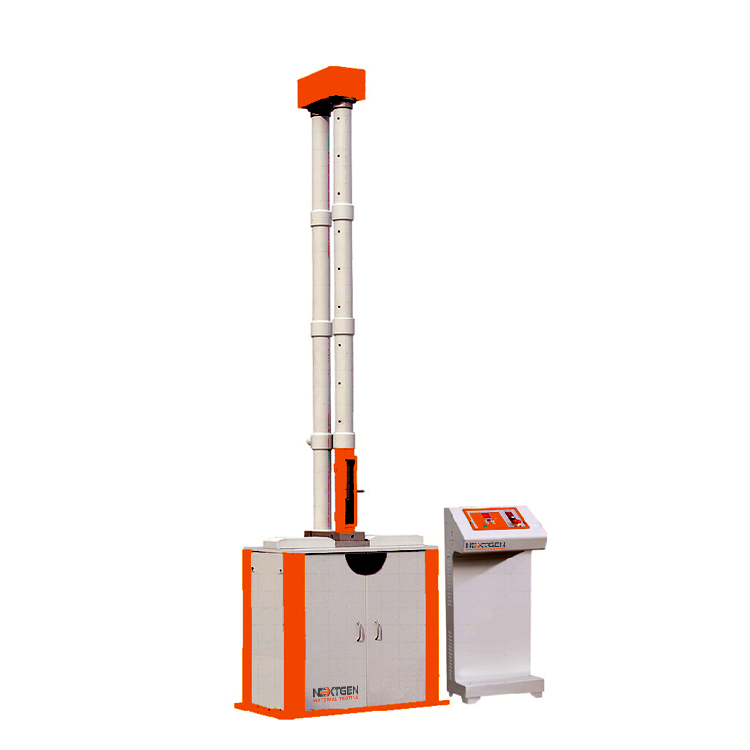
NG-ImpactFall – Falling Weight Impact Tester
Our falling weight impact tester finds extensive application in conducting external impact strength tests on plastic and non-metal materials.
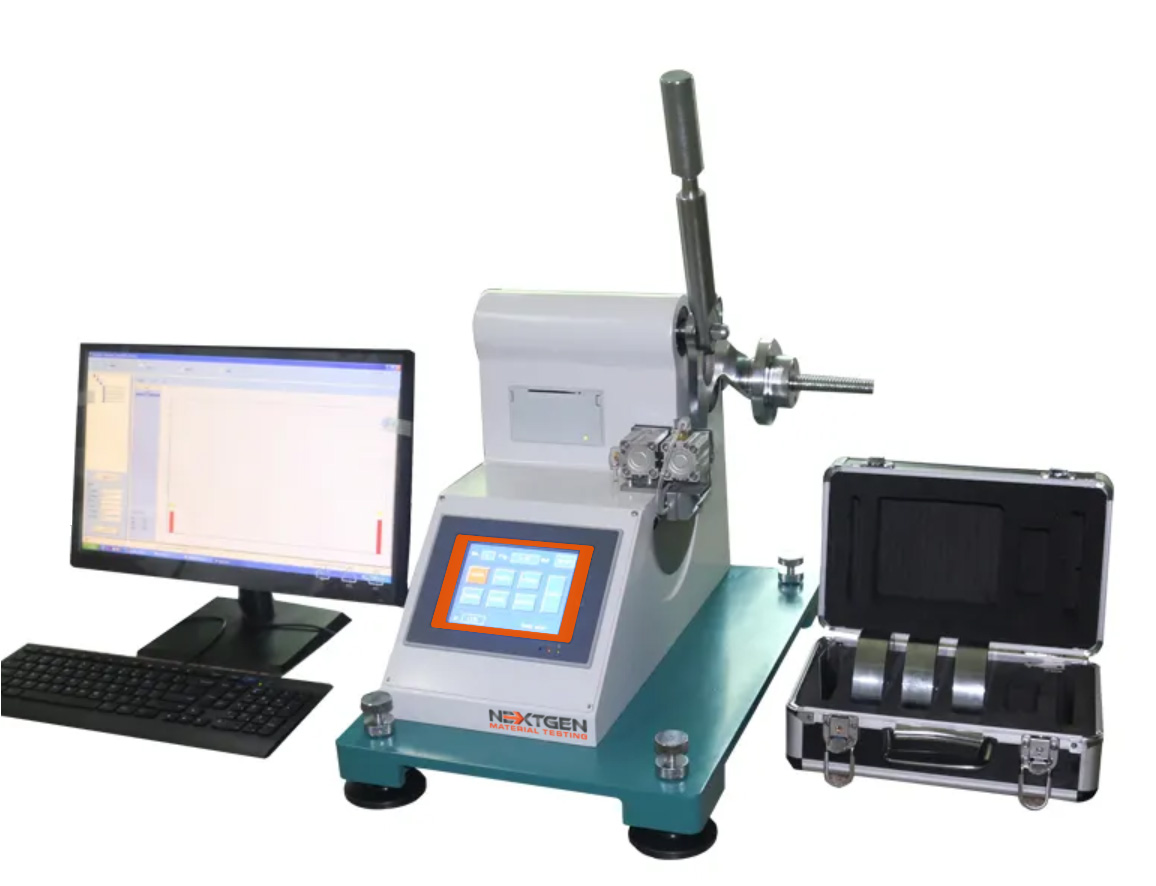
High Energy Elemendorf
Measure the tearing strength of plastic materials with the NG-HE Elemendorf, a versatile tester with advanced potential energy calculation.
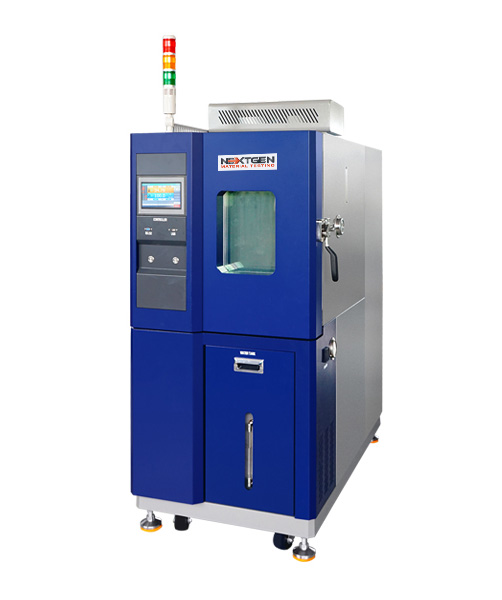
NextGen Environmental Chambers NG-EC 100,150,225,408,1000
The temperature and humidity NextGen Environmental Chambers features a sturdy cabinet made of cold-rolled steel and stainless steel.
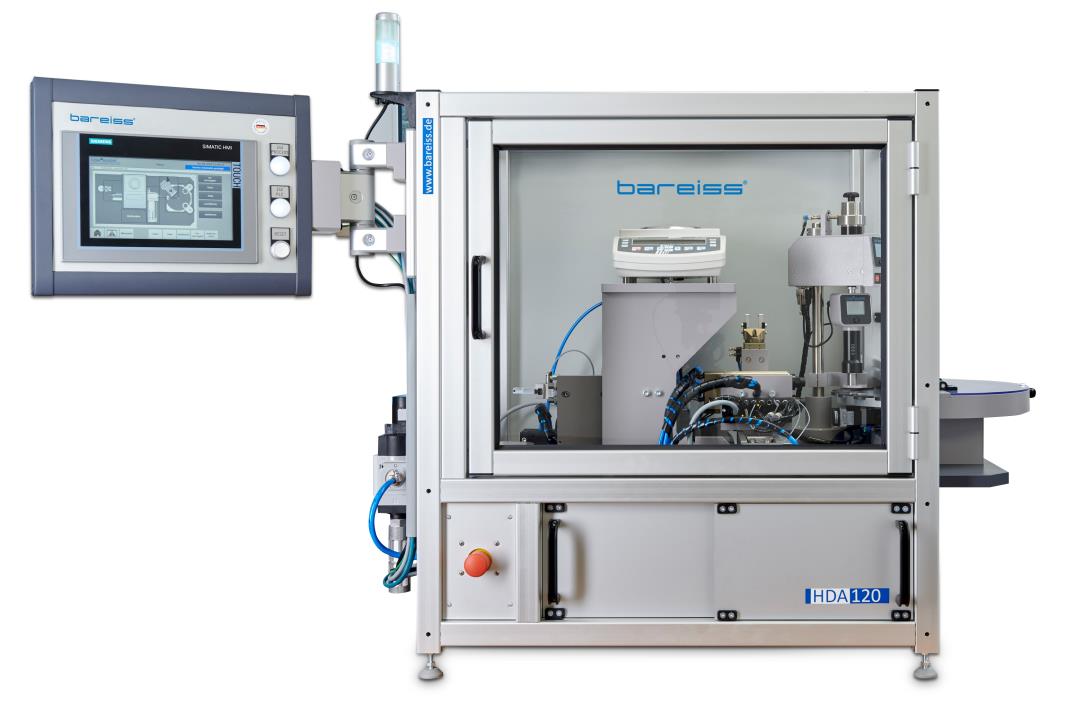
HDA 120 - Hardness and Density Automation Test System
The HDA 120 test system is a versatile solution for semi-automatic detection of sample hardness and density.
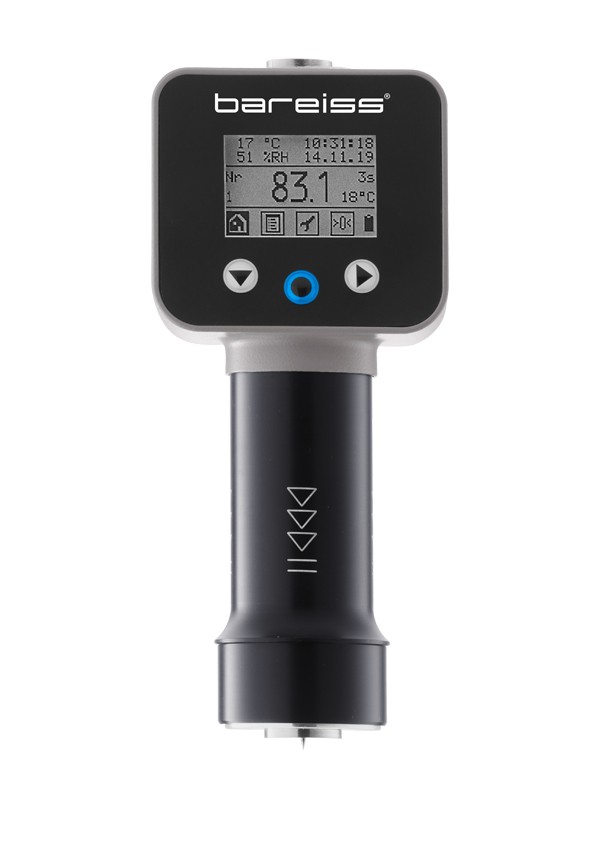
Advanced Portable Shore Durometer System with Test Stand Options
HPEIII is NextGen's advanced German line of equipment that is the new generation of HPE systems ideal for various plastic and plastic compound testing. The new system enhancements offer advantages including temperature sensor, reading values of ambient temperature and humidity, historical hardness value display, larger LCD display, standard USB connection and much more. These advanced portable systems can be paired up with either manual or automatic motorized test stands to help eliminate the human error factor and maximize accuracy and repeatability between test when switching from one operator to the next.
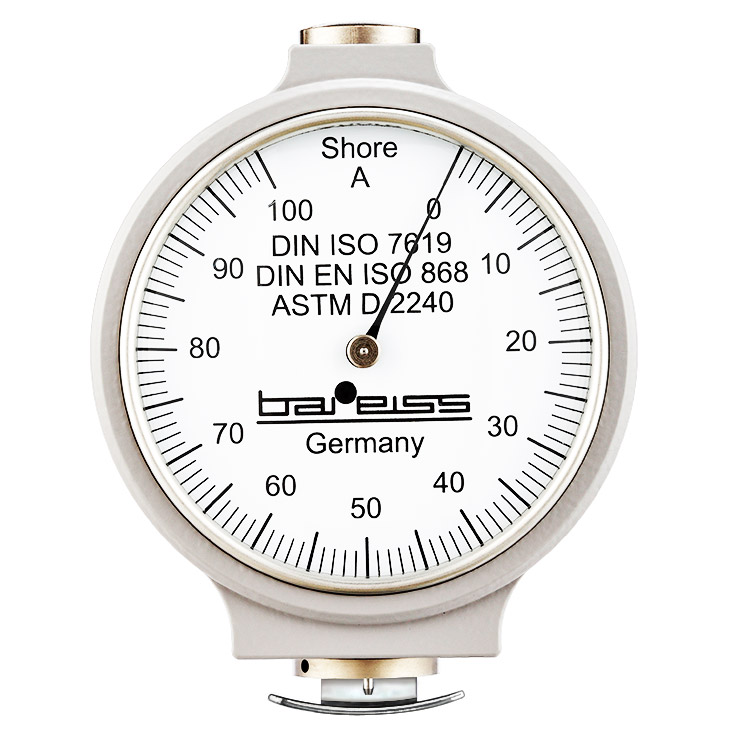
Classic Analogue Shore Durometer with Test Stand Options
This German-manufactured system has been the global benchmark of Shore hardness testing systems since 1954. With ever enhanced ergonomic design, the HP Shore Hardness Tester is both visually appealing and precise rubber and plastic testing system as it has been for nearly 50 years.
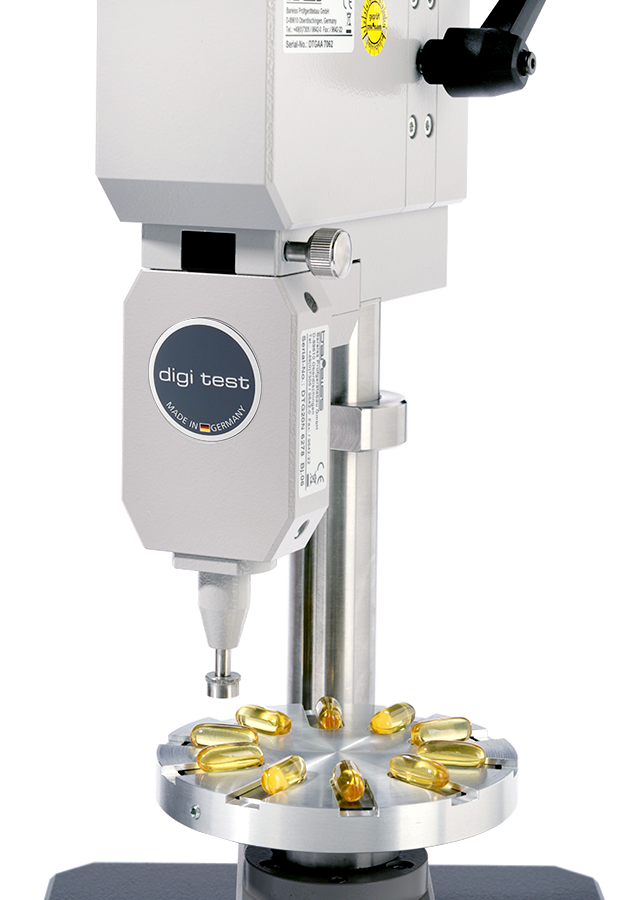
Automatic Capsule and Soft Gel Hardness Tester
Gelomat is an automatic capsule hardness tester designed for regular and soft gel capsule testing. This state of the art system is developed by the latest R&D technology to meet and exceed the highest quality standards for gelatin capsule testing. The system comes standard with your desired testing head and can be upgraded to optional accessories for maximum efficiency.
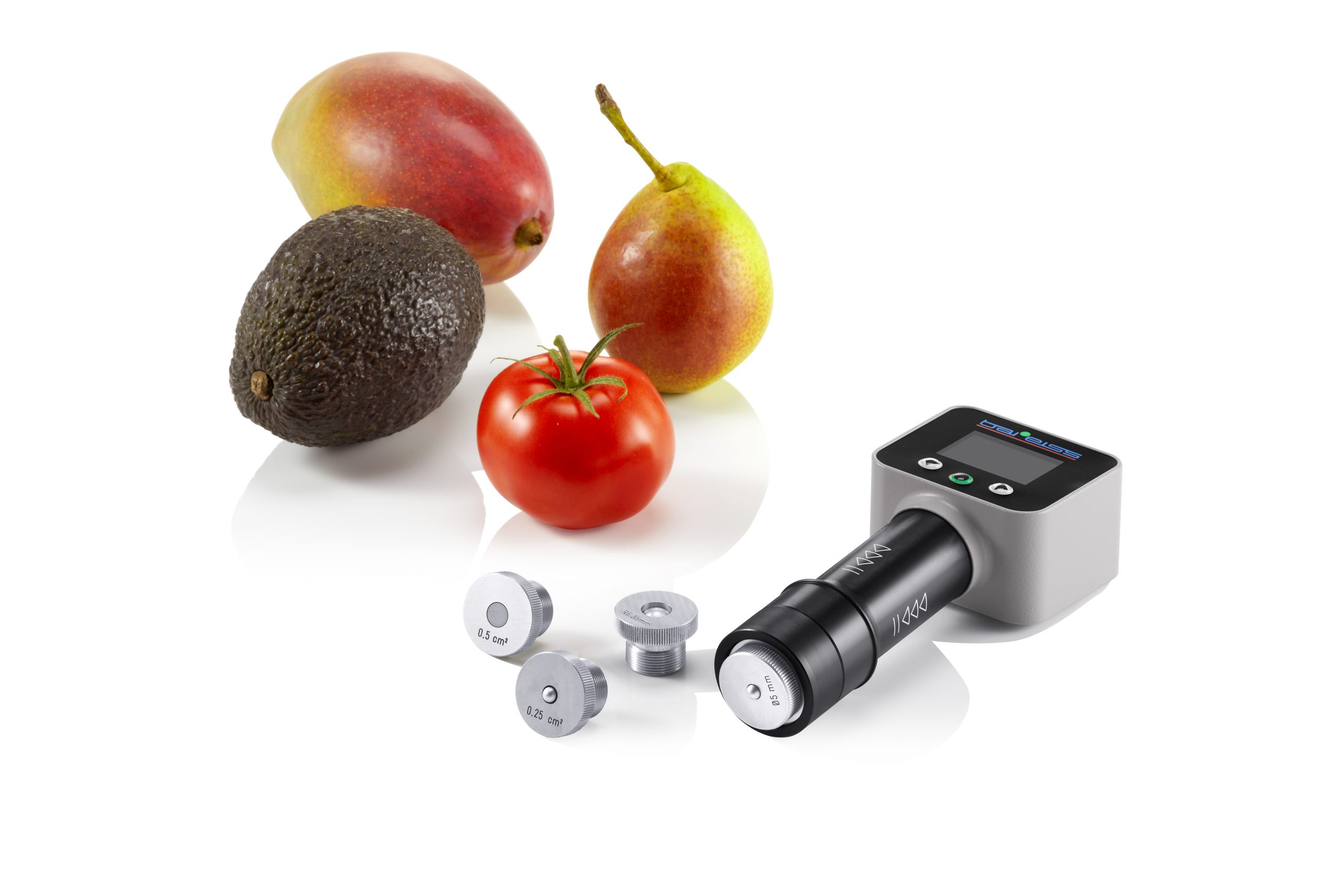
Fruit Firmness Tester
This German manufactured fruit firmness and fruit hardness testing device is designed specification for the determination of the pulp hardness of a given fruit. This state-of-the-art device is invaluable for trading companies serious about their quality control procedures. The unit helps identify the harvest date of the specific fruits relative to the time of transpirations and storage.
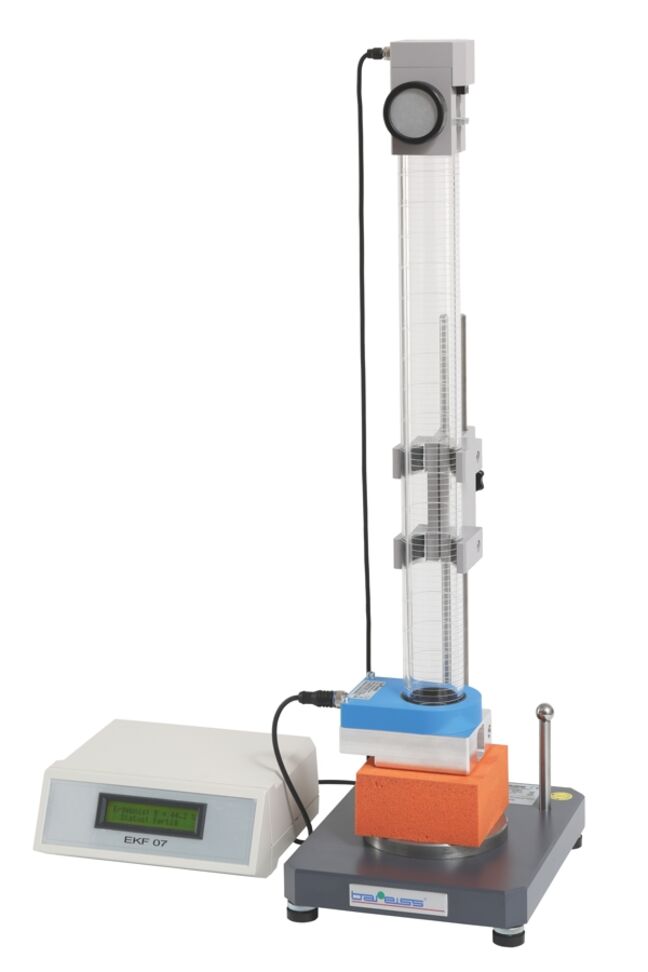
Ball Rebound Tester
Ball Rebound Tester is designed for measuring the rebound resilience of polymer foams.
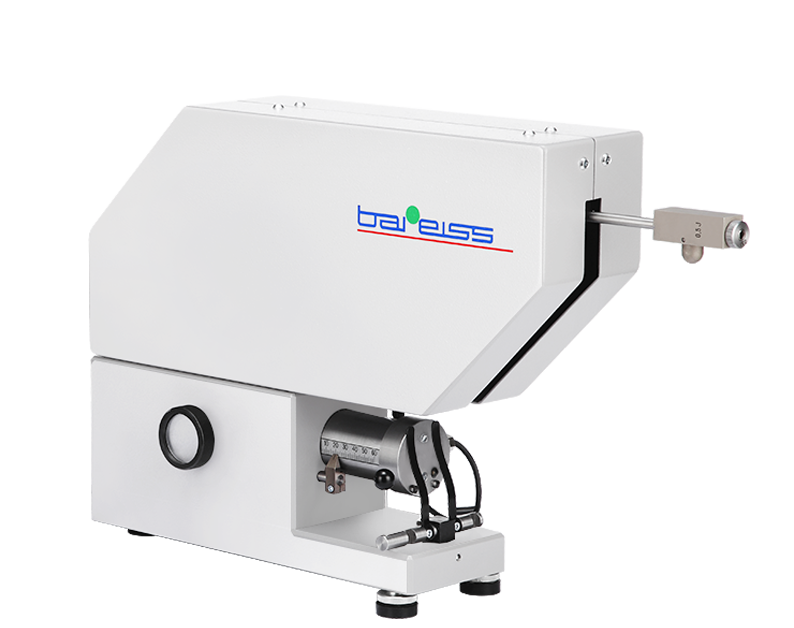
Pendulum Rebound Resilience Tester
Manual and Fully-Automatic Pendulum Rebound Resilience Tester. These rebound testers will determine the dynamic behavior of various materials and supply the differentiation of these materials' qualities. It will also identify material changes after aging and fatigue. The Pendulum Rebound Tester is out there with an adjustable heater for sample temperatures up to 100 ℃. It can simulate the effect of heat on the elasticity of samples with different formulations.
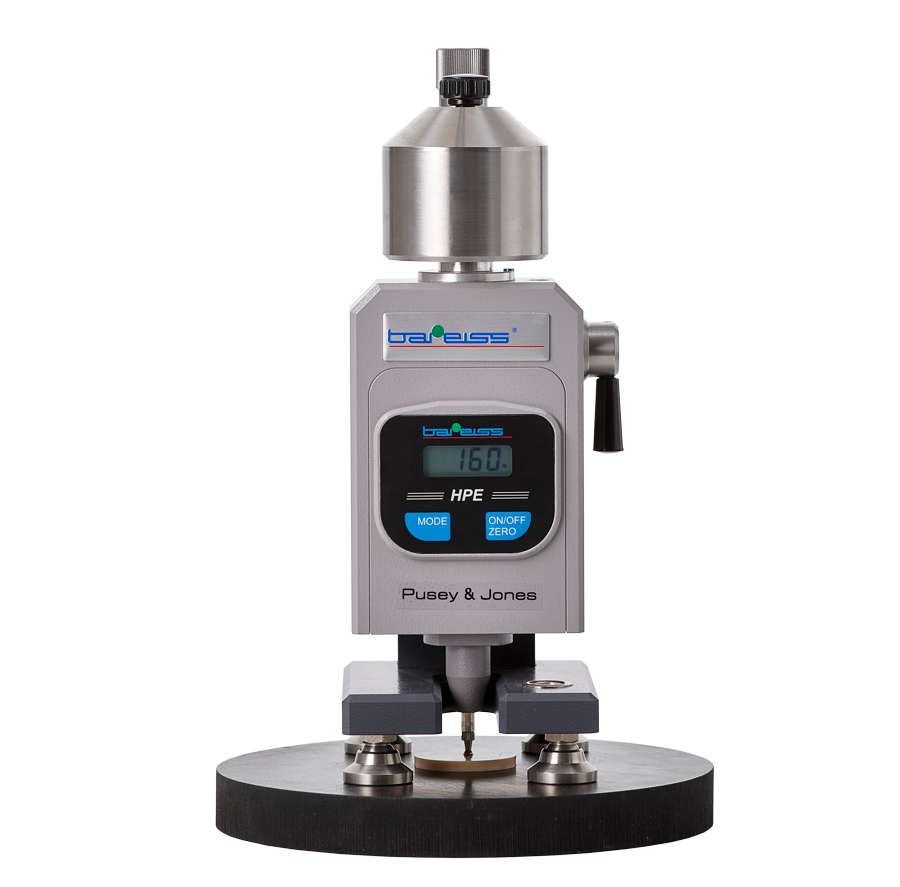
Pusey & Jones Tester
Pusey & Jones is a rubber and rubber like material testing system. The unit is designed for testing rubber rollers in the paper industry. The system can test specimens with flat surfaces and thickness of 13 mm.
